

7 Popular Sailboats with Two Masts (With Pictures & Prices)
Sailboats can come with one, two, or even more masts. You can also have different-sized masts placed on the front, back, or middle of your vessel.
Below, I have listed popular sailboats that have two masts.
Let’s get started!
Table of Contents
Check also: Average sailboat price examples .
Things to Know About Sailboats With Two Masts
When looking for sailboats with two masts, you should know what you are looking for. A Ketch is one type of sailboat with two masts.
Knowing this term can help you to nail down your search when looking for a boat with two masts.
These boats come in many shapes and sizes as well as many different types of designs. Generally, these types of boats have the taller mast being forward and the smaller mast near the aft.
Yawls are also boats that feature two masts.
These also come in multiple types and designs. The difference between the Ketch and the Yawl is that the Yawl has the larger mast in the aft instead of forward. They also have smaller sails and can be easier to handle.
Another type of sailing ship that features two masts is a Brigantine.
This ship has mixed sailing rigs which commonly features squared sails on the front part of the ship and triangular sails on the back of the ship.
These boats are often larger and require more people to handle them.
7 Great Used Boats with Two Masts
There are many benefits to used boats including a lower cost. You can get a larger boat for a lower cost if you choose to buy used.
When looking at used boats, you need to make sure you look at the boat and its features thoroughly to make sure everything is in great working order.
If you do not feel confident that you can properly look over a used vessel, you can even hire a marine inspector to look it over and let you know of any potential issues or needed repairs. You can use this assessment to decide what is worth it, or if the needed repairs fall into the budget.
It is much more common for a used boat to have more than one mast. This is because the newer sailboat models are creating their new designs with just one mast.
One mast ships are easier to handle and manage so new designs are trying to optimize design and ease of sailing.
Below are great used sailboats with two masts which I have arranged by price .
1. 1976 Westerly Center Cockpit Ketch

This 1976 Westerly Center Cockpit Ketch is a small 36-foot long sailboat with two masts. This is a solidly built cruising vessel that features a center cockpit ketch layout.
This boat has a small 38 horsepower engine perfectly fit to navigate its smaller size.
The interior features 1 single berth and 3 double berths all in 3 cabins. This boat also has 2 full heads onboard.
You also have a full galley with a 4 burner stove, refrigerator and freezer, stainless steel sink, and microwave oven.
This boat makes great use of limited space and offers many amenities in a much smaller frame.
Price: $37,000.00
2. 1978 Jeanneau Gin Fizz

The 1978 Jeanneau Gin Fizz is a trusted and popular two-masted design capable of crossing the Atlantic Ocean .
This boat is also very spacious for a boat that is only 38 feet in length. This model also won an award for “security, comfort, ease of handling, and ability to handle varying conditions.”
This particular used model has been well maintained and upgraded over the years.
This boat is great for family cruising, offshore passages, and even racing.
This boat features a 50 horsepower engine to help navigation.
Inside you can find 2 cabins and 1 head. You will be highly comfortable with air conditioning and other interior luxuries.
Price: $46,000.00
3. 1979 Freedom 40
The Freedom 40 is a classically designed centerboard ketch with two masts. This boat is a great sailor loaded for cruising on the wide-open blue water.
This sailboat is 40 feet in length and features accommodations for six people that include a double-v berth, another double berth, and two single berths.
There is also a full head that can be accessed both from the main salon and aft cabin.
This boat was recently painted and features newer interior fabrics, forced air heating, and much more.
You can find a dinette with separate freezer and refrigeration compartments, a stove with an oven and broiler, a double stainless steel sink, plenty of storage, and other interior features.
This boat also comes with an outboard motor with 50 horsepower and a hard bottom inflatable dinghy.
Price: $54,900.00
4. 1977 Puma 38 Ketch

The Puma 38 Ketch is a two-masted sailboat built for racing like the rest of the Puma sailing line. This brand prides itself on speed and maneuverability.
The 1977 Puma 38 is 34 feet in length with a backup diesel engine that can help you get where you need to go as well as docking into a slip. This motor features more horsepower than the average sailboat with 45 horsepower.
Features on this vessel include autopilot, electrical and manual bilge pumps, a full marine head, running hot water, and refrigerator.
This boat is made of fiberglass with teak finishes and looks well kept. You can find this boat in Spain if you are interested in purchasing it.
Price: $66,099.00
5. 1973 Morgan Out Island 41
Originally designed by Charley Morgan, the Morgan Out Island 41 is a center cockpit shoal-draft cruiser that features two masts.
This larger boat is 41 feet 3 inches in length and features many amenities.
This boat is the tri-cabin version and features interior heating, pressurized hot and cold water, a 2 burner gas oven, and a fridge.
This boat also seats up to 7 in the 3 cabins and the saloon. There are also 2 full heads on this vessel.
This boat is even equipped with an inboard motor . Inboard motors are easier when it comes to navigation including backing up, which is generally hard for sailboats to do.
Price: $68,596.00
6. 1970 Hinckley Bermuda 40

This 1970 Hinckley Bermuda 40 is a gorgeous two-masted boat painted with a mixture of desert sand and oyster white on the exterior and features a beautiful and well-kept deck.
This boat has previously had all her systems replaced and upgraded and features a 40 horsepower engine that was new in 2014.
This boat features a mahogany interior and sleeps up to 6 people in 2 cabins. You can also find a 3 burner propane stove with oven, fridge and compressor, new countertops and plenty of storage.
This boat is a stunning and highly upgraded “must-see” at a very reasonable price.
Price: $129,500.00
7. 1995 Amel Super Maramu

A newer model of sailboat is the 1995 Amel Super Maramu sailboat. This sailboat has two masts and is very long at 53 feet.
This boat features an aft deck, steps molded right into the hull, well-protected cockpit an many other features. This boat has a large 76 horsepower engine which is more than the average sailboat is equipped with.
Inside, this boat features 2 cabins and 2 heads with showers. There is also plenty of storage, air conditioning , and electric heaters. There is also a nice salon and galley with a refrigerator, dishwasher, chest freezer, microwave oven, 3 burner stove, and other appliances.
This boat is great for multiple days out on the water and is new and updated. Because of the year, this was manufactured and the features, this boat has a larger price tag than the previous models.
Price: $299,990.00
Final Thoughts:
Sailboats are a great way to enjoy a day out at sea. Most sailboat models come with sleeping arrangements and even a kitchen. This makes them ideal for trips that will take more than a day.
Having multiple masts allows you to harness the power of the wind better and can increase your speed and directional capabilities.
There are many great choices when it comes to boats with two masts, but newer models are starting to steer away from double mast designs. This does not mean that you cannot get a good boat with two masts.
Used boats can be great choices when it comes to purchasing a boat. This is even more true with large, yacht boats such as the ones listed above.
Just make sure when you buy a used sailboat you check that everything is intact and in good working order and if it is not, you have allotted space in the budget to fix what is needed.
Your new double-masted sailboat should provide you with plenty of long-lasting memories and adventures out on the water while you connect with the wind and the sea.
Click to share...

What’s a Boat with Two Masts Called: Two masted sailing boat types
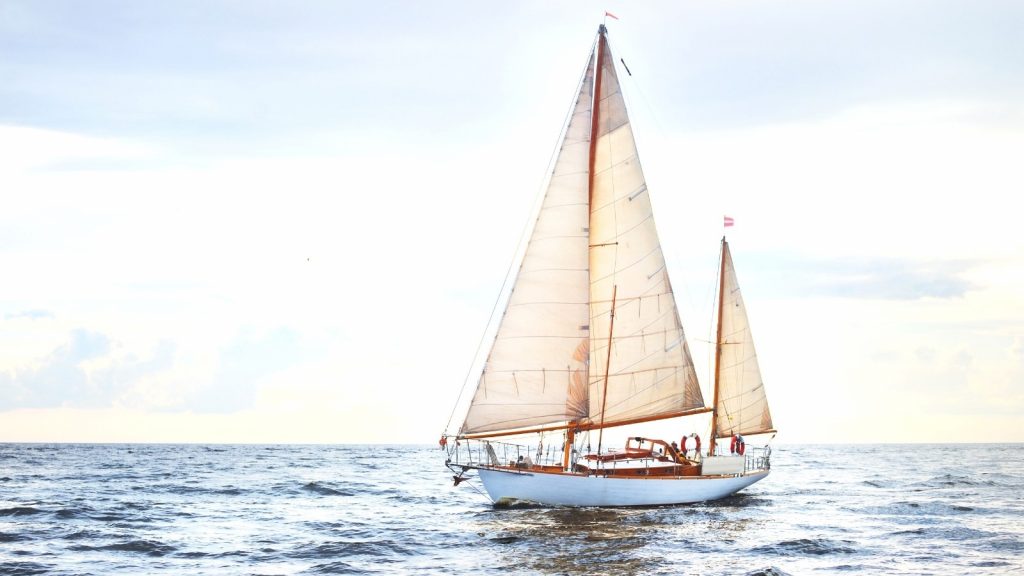
Two-masted sailing boats will always have a special place in the hearts of many sailors. Many sailors consider two-masted sailing boats to be the most attractive and graceful of all sailing vessels. They have an obvious elegance, but what do you know about these two masted sailboats? Let’s find out!
Among the most important aspects are the fact that two-masted sailing boats offer greater sail balance, engineless sailing and more heavy weather options.
Even if the two masted sailboats are not so common, the sailing world has a few of them and what is more, they represent a proof of the evolution and improvement of sailing boats over time. There are an almost endless number of ways sailors have arranged their sails on boats over the years.

Two-masted sailing boats are classified according to the size and position of their masts.
There are different two-masted sailing boat types and two of the most popular are schooners and yawls.
The origins of schooner-rigged vessels are unknown, however there is evidence of them in paintings by Dutch maritime painters dating back to the early 17th century.
Schooners were developed by Northern European countries, while yawls are believed to be descended from the fishing boats of England.
Sailboats with two masts include yawls, ketches, schooners and brigs (known as brigantines). Yawls and ketches are both types of sloops, which means they have one mast, but the difference between them is that the yawl has a second mast stepped at the bow.
Ketches and Yawls have a lower mast, unlike schooners that have a taller aft mast, which is also known as mizzen. Ketch sailing boats have something specific: the aft mast is located in front of the rudder post.
The yawl’s mizzenmast serves as a counterbalance for the jib sails, so that it doesn’t have to be hung from the forestay (the rope running from the top of the mast down to the deck). They’re usually smaller than ketches and have less rigging because they don’t carry as many sails as a sloop with two masts.
Yawls are faster sailboats than schooners because they’re lighter, more balanced and easier to sail upwind. They can also go faster because their shorter sails catch more wind. But schooners have larger payloads, which means more people or cargo — an important consideration for long trips without resupply.

Schooners are two-masted sailing boats, but instead of having a jib sail like yawls, ketches and most sloops, schooners have a fore-and-aft spanker sail like a gaff sailboat. These two-masted sailboats have at least two masts, the foremast being slightly shorter than the main mast.
Schooners are larger than yawls, ketches and other sloops and weren’t used very much in modern times because they were more difficult to handle. They’re still used in racing competitions today.
Schooners have a longer bow portion than yawls. The mainsail is aft of the mast, and either one or two foresails are in front of it. In a schooner, these are triangular sails; in a yawl, they’re trapezoidal. Yawls have bowsprits — poles that extend beyond the bow for the jib and stay sail to be attached. Schooners have small bowsprits that can support jibs but not large sails.

The term ketch derives from the word catch, which hints to how it got its name in the 17th century. Ketches were initially intended to meet the specific requirements of offshore net fishing.
Ketch is a type of sailboat that features two masts and two sails, commonly used as a racing and cruising boat. The mainmast of this two-masted sailboat is typically taller than the mizzen mast (aft-mast). Its name derives from catch.
Taller masts allow you to use larger sails, so ketch boats are able to achieve better speeds than similar boats with only one mast. Some ketch designs feature a gaff rig, which is similar to a yawl, while others feature a yawl rig, which looks like a traditional sloop.
Ketch boats may look easy to sail but the slightest mistake can lead to disaster. You must be careful when operating this type of boat because it does not have as much stability as other boats, especially when you’re manoeuvring in tight quarters or windy conditions.
A ketch may also be a small recreational boat with only one head-sail in use. Many modern designs have moved away from sail altogether and are powered by engine, while others use both sails as well as engines depending on circumstance.

The brigantine was once a tiny ship that carried both oars and sails. It was a favorite of Mediterranean pirates.
A brigantine is a square-rigged sailing boat with two masts, with a fully square-rigged foremast and two sails on the mainmast.
The mainmast is stepped forward of the deck, making it possible to sail into the wind using a triangular headsail known as a jib. The brig’s foremast is shorter than the mainmast.
The name of this type of boat with 2 masts is derived from the Italian word “brigantino”, which means brigand.
Also, this two-masted sailing boat type was most commonly used for coastal trade and pirate hunting. The brigantine had an advantage over other ships of the time because it could sail against the wind using both sails, making it easier to travel against strong winds.
Faster and easier to manoeuvre than a sloop or schooner, it was used for piracy and espionage.

FAQ: Two-Masted Sailboats
What do you call a two-masted sailboat.
Two-masted sailboats are of several types: yawls, schooners, ketches or brigantines.
Why do some sailboats have two masts?
The vast majority of sailboats feature a mainsail and a jib. These two-masted sailboats provide several advantages in terms of speed and maneuverability. These two masts may be configured in a variety of ways.
The foresail directs air beyond the back of the mainsail, generating greater power from the wind. In order to help menouvering, the foresail can be backed. So, adding sails makes things simpler for bigger boats, making them easier to handle in heavy winds.
What is the difference between a ketch and a yawl sailboat?
Because they are lighter, more balanced, and easier to sail upwind, yawls are faster sailboats than schooners. They can also go at a faster speed since their shorter sails collect more wind. Schooners, on the other hand, have higher cargoes, which means more people or freight – a crucial consideration for extended journeys without replenishing.
What is a one masted sailboat?
It's a sailing boat having a single mast roughly one-third the length's aft of the bow. A sailboat with a single mast usually has one headsail in front of the mast and one mainsail behind the mast.
What is a two-masted square rigger?
It's a brig with two square-rigged masts. A gaff-rigged fore-and-aft sail also called a "mizzen" is used in addition to jibs and staysails (stays'ls) before the foremast and staysails between the masts.
Leave a Comment Cancel Reply
Your email address will not be published. Required fields are marked *

Types of Sailboats: A Complete Guide

Last Updated by
Daniel Wade
June 15, 2022
Learning the different types of sailboats can help you identify vessels and choose the right boat.
In this article, we'll cover the most common kinds of sailboats, their origins, and what they're used for. We'll also go over the strengths and weaknesses of each design, along with when they're most useful.
The most common kind of sailboat is the sloop, as it's simple to operate and versatile. Other common sailboat types include the schooner, cutter, cat, ketch, schooner, catamaran, and trimaran. Other sailboat variations include pocket cruisers, motorsailers, displacement, and shoal-draft vessels.
The information found in this article is sourced from boat reference guides, including A Field Guide to Sailboats of North America by Richard M. Sherwood and trusted sources in the sailing community.
Table of contents
Distinguishing Types of Sailboats
In this article, we'll distinguish sailboats by traits such as their hull type, rig, and general configuration. Some sailboats share multiple characteristics with other boats but fall into a completely different category. For example, a sailboat with a Bermuda rig, a large engine, and a pilothouse could technically be called a sloop, but it's more likely a motorsailer.
When discerning sailboat type, the first most obvious place to look is the hull. If it has only one hull, you can immediately eliminate the trimaran and the catamaran. If it has two or more hulls, it's certainly not a typical monohull vessel.
The next trait to consider is the rig. You can tell a lot about a sailboat based on its rig, including what it's designed to be used for. For example, a long and slender sailboat with a tall triangular rig is likely designed for speed or racing, whereas a wide vessel with a complex gaff rig is probably built for offshore cruising.
Other factors that determine boat type include hull shape, overall length, cabin size, sail plan, and displacement. Hull material also plays a role, but every major type of sailboat has been built in both wood and fiberglass at some point.
Sailboat vs. Motorsailer
Most sailboats have motors, but most motorized sailboats are not motorsailers. A motorsailer is a specific kind of sailboat designed to run efficiently under sail and power, and sometimes both.
Most sailboats have an auxiliary engine, though these power plants are designed primarily for maneuvering. These vessels cannot achieve reasonable speed or fuel-efficiency. Motorsailers can operate like a powerboat.
Motorsailers provide great flexibility on short runs. They're great family boats, and they're popular in coastal communities with heavy boat traffic. However, these features come at a cost. Motorsailers aren't the fastest or most efficient powerboats, and they're also not the most agile sailboats. That said, they make an excellent general-purpose sailing craft.
Monohull vs. Multi-hull: Which is Better?
Multihull sailboats are increasingly popular, thanks to advances and lightweight materials, and sailboat design. But are they better than traditional sailboats? Monohulls are easier to maintain and less expensive, and they offer better interior layouts. Multihulls are more stable and comfortable, and they're significantly easier to control. Multihull sailboats also have a speed advantage.
Monohull Sailboats
A monohull sailboat is a traditionally-shaped vessel with a single hull. The vast majority of consumer sailboats are monohulls, as they're inexpensive to produce and easy to handle. Monohull sailboats are proven and easy to maintain, though they lack the initial stability and motion comfort of multi-hull vessels.
Monohull sailboats have a much greater rig variety than multi-hull sailboats. The vast majority of multihull sailboats have a single mast, whereas multi-masted vessels such as yawls and schooners are always monohulls. Some multi-hull sailboats have side-by-side masts, but these are the exception.
Catamaran Sailboats
The second most common sailboat configuration is the catamaran. A catamaran is a multihull sailboat that has two symmetrical hulls placed side-by-side and connected with a deck. This basic design has been used for hundreds of years, and it experienced a big resurgence in the fiberglass boat era.
Catamarans are fast, efficient, and comfortable. They don't heel very much, as this design has excellent initial stability. The primary drawback of the catamaran is below decks. The cabin of a catamaran is split between both hulls, which often leaves less space for the galley, head, and living areas.
Trimaran Sailboats
Trimarans are multi-hull sailboats similar to catamarans. Trimarans have three hulls arranged side-by-side. The profile of a trimaran is often indistinguishable from a catamaran.
Trimarans are increasingly popular, as they're faster than catamarans and monohulls and considerably easier to control. Trimarans suffer from the same spatial limitations as catamarans. The addition of an extra hull adds additional space, which is one reason why these multi-hull vessels are some of the best-selling sailboats on the market today.
Sailboat Rig Types
Rigging is another way to distinguish sailboat types. The rig of a sailboat refers to it's mast and sail configuration. Here are the most common types of sailboat rigs and what they're used for.
Sloops are the most common type of sailboat on the water today. A sloop is a simple single-mast rig that usually incorporates a tall triangular mainsail and headsail. The sloop rig is easy to control, fun to sail, and versatile. Sloops are common on racing sailboats as they can sail quite close to the wind. These maneuverable sailboats also have excellent windward performance.
The sloop rig is popular because it works well in almost any situation. That said, other more complex rigs offer finer control and superior performance for some hull types. Additionally, sloops spread their entire sail area over just to canvases, which is less flexible than multi-masted rigs. The sloop is ideal for general-purpose sailing, and it's proven itself inland and offshore.
Sloop Features:
- Most popular sailboat rig
- Single mast
- One mainsail and headsail
- Typically Bermuda-rigged
- Easy to handle
- Great windward performance
- Less precise control
- Easier to capsize
- Requires a tall mast
Suitable Uses:
- Offshore cruising
- Coastal cruising
Cat (Catboat)
The cat (or catboat) is a single-masted sailboat with a large, single mainsail. Catboats have a thick forward mast, no headsail, and an exceptionally long boom. These vessels are typically gaff-rigged, as this four-edged rig offers greater sail area with a shorter mast. Catboats were popular workboats in New England around the turn of the century, and they have a large following today.
Catboats are typically short and wide, which provides excellent stability in rough coastal conditions. They're hardy and seaworthy vessels, but they're slow and not ideal for offshore use. Catboats are simple and easy to control, as they only have a single gaff sail. Catboats are easy to spot thanks to their forward-mounted mast and enormous mainsail.
Catboat Features:
- Far forward-mounted single mast
- Large four-sided gaff sail
- Short and wide with a large cockpit
- Usually between 20 and 30 feet in length
- Excellent workboats
- Tough and useful design
- Great for fishing
- Large cockpit and cabin
- Not ideal for offshore sailing
- Single sail offers less precise control
- Slow compared to other rigs
- Inland cruising
At first glance, a cutter is difficult to distinguish from a sloop. Both vessels have a single mast located in roughly the same position, but the sail plan is dramatically different. The cutter uses two headsails and often incorporates a large spar that extends from the bow (called a bowsprit).
The additional headsail is called a staysail. A sloop only carries one headsail, which is typically a jib. Cutter headsails have a lower center of gravity which provides superior performance in rough weather. It's more difficult to capsize a cutter, and they offer more precise control than a sloop. Cutters have more complex rigging, which is a disadvantage for some people.
Cutter Features:
- Two headsails
- Long bowsprit
- Similar to sloop
- Gaff or Bermuda-rigged
- Fast and efficient
- Offers precise control
- Superior rough-weather performance
- More complex than the sloop rig
- Harder to handle than simpler rigs
Perhaps the most majestic type of sailboat rig, the schooner is a multi-masted vessel with plenty of history and rugged seaworthiness. The schooner is typically gaff-rigged with short masts and multiple sails. Schooners are fast and powerful vessels with a complex rig. These sailboats have excellent offshore handling characteristics.
Schooners have a minimum of two masts, but some have three or more. The aftermost large sail is the mainsail, and the nearly identical forward sail is called the foresail. Schooners can have one or more headsail, which includes a cutter-style staysail. Some schooners have an additional smaller sale aft of the mainsail called the mizzen.
Schooner Features:
- At least two masts
- Usually gaff-rigged
- One or more headsails
- Excellent offshore handling
- Precise control
- Numerous sail options (headsails, topsails, mizzen)
- Fast and powerful
- Complex and labor-intensive rig
- Difficult to adjust rig single-handed
- Offshore fishing
Picture a ketch as a sloop or a cutter with an extra mast behind the mainsail. These vessels are seaworthy, powerful, excellent for offshore cruising. A ketch is similar to a yawl, except its larger mizzen doesn't hang off the stern. The ketch is either gaff or Bermuda-rigged.
Ketch-rigged sailboats have smaller sails, and thus, shorter masts. This makes them more durable and controllable in rough weather. The mizzen can help the boat steer itself, which is advantageous on offshore voyages. A ketch is likely slower than a sloop or a cutter, which means you aren't likely to find one winning a race.
Ketch Features:
- Headsail (or headsails), mainsail, and mizzen
- Mizzen doesn't extend past the rudder post
- Good offshore handling
- Controllable and mild
- Shorter and stronger masts
- Easy self-steering
- Slower than sloops and cutters
- Less common on the used market
A dinghy is a general term for a small sailboat of fewer than 28 feet overall. Dinghys are often dual-power boats, which means they usually have oars or a small outboard in addition to a sail. These small boats are open-top and only suitable for cruising in protected waters. Many larger sailboats have a deployable dinghy on board to get to shore when at anchor.
Dinghy Features:
- One or two people maximum capacity
- Easy to sail
- Works with oars, sails, or an outboard
- Great auxiliary boat
- Small and exposed
- Not suitable for offshore use
- Going from anchor to shore
- Protected recreational sailing (lakes, rivers, and harbors)
Best Sailboat Type for Stability
Stability is a factor that varies widely between sailboat types. There are different types of stability, and some sailors prefer one over another. For initial stability, the trimaran wins with little contest. This is because these vessels have a very high beam-to-length ratio, which makes them much less prone to rolling. Next up is the catamaran, which enjoys the same benefit from a wide beam but lacks the additional support of a center hull section.
It's clear that in most conditions, multihull vessels have the greatest stability. But what about in rough weather? And what about capsizing? Multihull sailboats are impossible to right after a knockdown. This is where full-keel monohull sailboats excel.
Traditional vessels with deep displacement keels are the safest and most stable in rough weather. The shape, depth, and weight of their keels keep them from knocking over and rolling excessively. In many cases, these sailboats will suffer a dismasting long before a knockdown. The primary disadvantage of deep-keeled sailboats is their tendency to heel excessively. This characteristic isn't hazardous, though it can make novice sailors nervous and reduce cabin comfort while underway.
Best Sailboat Type for Offshore Cruising
The best sailboat type for offshore cruising is the schooner. These graceful aid robust vessels have proven themselves over centuries as durable and capable vessels. They typically use deep displacement keels, which makes them stable in rough weather and easy to keep on course.
That said, the full answer isn't quite so simple. Modern multihull designs are an attractive option, and they have also proven to be strong and safe designs. Multihull sailboats are an increasingly popular option for offshore sailors, and they offer comfort that was previously unknown in the sailing community.
Many sailors cross oceans in basic Bermuda-rigged monohulls and take full advantage of a fin-keel design speed. At the end of the day, the best offshore cruising sailboat is whatever you are comfortable handling and living aboard. There are physical limits to all sailboat designs, though almost any vessel can make it across an ocean if piloted by a competent skipper and crew.
Best Sailboat Type for Racing The modern lightweight Bermuda-rigged sailboat is the king of the regatta. When designed with the right kind of hull, these vessels are some of the fastest sailboats ever developed. Many boats constructed between the 1970s and today incorporate these design features due to their favorable coastal and inland handling characteristics. Even small sailboats, such as the Cal 20 and the Catalina 22, benefit from this design. These boats are renowned for their speed and handling characteristics.
Related Articles
I've personally had thousands of questions about sailing and sailboats over the years. As I learn and experience sailing, and the community, I share the answers that work and make sense to me, here on Life of Sailing.
by this author
Learn About Sailboats
Most Recent

What Does "Sailing By The Lee" Mean?
October 3, 2023

The Best Sailing Schools And Programs: Reviews & Ratings
September 26, 2023
Important Legal Info
Lifeofsailing.com is a participant in the Amazon Services LLC Associates Program, an affiliate advertising program designed to provide a means for sites to earn advertising fees by advertising and linking to Amazon. This site also participates in other affiliate programs and is compensated for referring traffic and business to these companies.
Similar Posts

Affordable Sailboats You Can Build at Home
September 13, 2023

Best Small Sailboat Ornaments
September 12, 2023

Discover the Magic of Hydrofoil Sailboats
December 11, 2023
Popular Posts

Best Liveaboard Catamaran Sailboats
December 28, 2023

Can a Novice Sail Around the World?
Elizabeth O'Malley

4 Best Electric Outboard Motors

How Long Did It Take The Vikings To Sail To England?

10 Best Sailboat Brands (And Why)
December 20, 2023

7 Best Places To Liveaboard A Sailboat
Get the best sailing content.
Top Rated Posts
Lifeofsailing.com is a participant in the Amazon Services LLC Associates Program, an affiliate advertising program designed to provide a means for sites to earn advertising fees by advertising and linking to Amazon. This site also participates in other affiliate programs and is compensated for referring traffic and business to these companies. (866) 342-SAIL
© 2024 Life of Sailing Email: [email protected] Address: 11816 Inwood Rd #3024 Dallas, TX 75244 Disclaimer Privacy Policy
What Is A Boat With 2 Masts Called?
Sailboats have held and air of mystique and romance ever since the early explores sailed the globe.
However, the early trade ships were somewhat restricted in their ability to sail into, or against, the wind. As a result, the ships that discovered the new world were slaves to the directions the trade winds were blowing.
Today, thanks to advances in hull design, sail orientation and mast placement, there are numerous sailboat designs that use multiple sail configurations that can travel around the world in any direction at any time of year.
Over the years the types of sailboats have been reduced to a few well-performing designs. These designs are divided into the two main classifications of one-masted boats and those with two or more masts with each mast being capable of supporting one or more sails.

The sloop is the most common type of sailboat and has just one mast, placed roughly at midship, with up to three headsails attached to the mast by guy lines. Boats with 2 masts or more are the ketch, yawl, brigantine, brig and the schooner , with the schooners having two, three, or in rare cases, four masts.
Many sailors like the ketch-rigged design for its off-shore performance, comfort and overall balance. This design has a main and mizzen sail, with the mainsail set in approximately the same position as on a sloop, The mizzen is a smaller mast sail set towards the rear of the boat.
The concept behind the two-sail setup on the ketch-rigged sailboat is that it provides two smaller sails that provide more overall sail area than the single sail design.

In theory the smaller sails are easier to work with in heavy off-shore winds, making the boat much easier to sail in storms. Because of the smaller and easier-to-handle sails, the design is a good choice for long distance short-handed sailing.
The mizzen sail also acts as sort of a “rudder” in helping to keep the boat sailing in the proper direction because of the downward force the mizzen applies to the rear of the boat.
Comfort is another strong selling point of this design. Whereas most sailboats are designed with the cockpit at the stern of the boat, this sailboat has a center cockpit design to allow for the placement of the mizzen sail aft.
Having the cockpit in the middle of the boat allows for more headroom below deck at the rear of the boat and a larger aft cabin. Additionally, unlike an aft cockpit that usually has the rear open to the ocean, a center cockpit is fully enclosed. This offers protection from the elements while at sea and makes for a much nicer sitting area.
The ketch-rigged sailboat is a time-proven rig that has made untold circumnavigations of the globe. For sailors who like the two-mast design, this sailboat is a hard choice to beat.
The yawl is also equipped with a main and a mizzen mast. However, a yawl typically has a smaller mizzen with the mast set aft of the rudder post.
There are as many arguments about whether the yawl is a practical off-shore design as there are species of fish in the ocean. While there are some that site the sail plan of the yawl as more aesthetic than functional, there are many long-time professional sailors who swear by the yawl design.
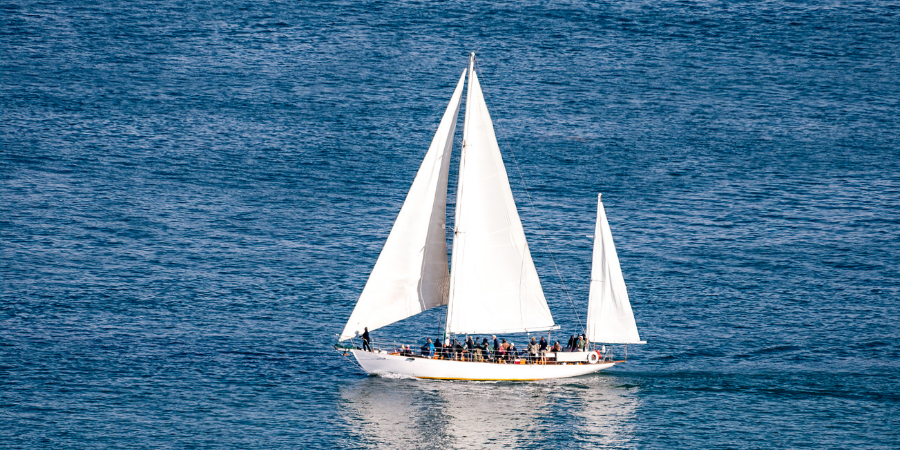
In theory, at least, the rear mast works as a rudder similarly to the ketch-rigged sailboat. The arguments typically start over the size and placement of the mizzen mast.
Some claim that placing the mizzen further back aids in helping to steer the boat. The other side of the argument is the reduced sail size makes it less efficient.
There is also the point that some sailors feel the mizzen being placed further back aids in heaving, or changing direction, and helps with steadying the boat at anchor.
Still, most sailors familiar with both the ketch and yawl say that the mizzen on the yawl is not a match for that of the ketch-rigged sailboat.
Brigantine and the Brig
Of similar, but not identical design, the brigantine and brig fall into the category of “clipper” or merchant ships.

Both are two-masted boats with the brigantine having square sails on the foremost mast and gaff sails on the mainmast. Here note that the smaller foremast is set forward of mast for the main sail.
Gaff sails are a four-cornered sail design attached to horizontal pole that hangs from the mast. Because of the smaller design, gaffs sails are more easily handled. In contrast, the brig uses square sails on both masts.
Both ships handle both coastal waters and ocean crossings as the square sails are well suited for sailing the trade wind routes.
A schooner is another boat with 2 masts, but can also have more. Like the brig and brigantine, a two-masted schooner has a foremast and an aft mast, the latter essentially being the mainmast.
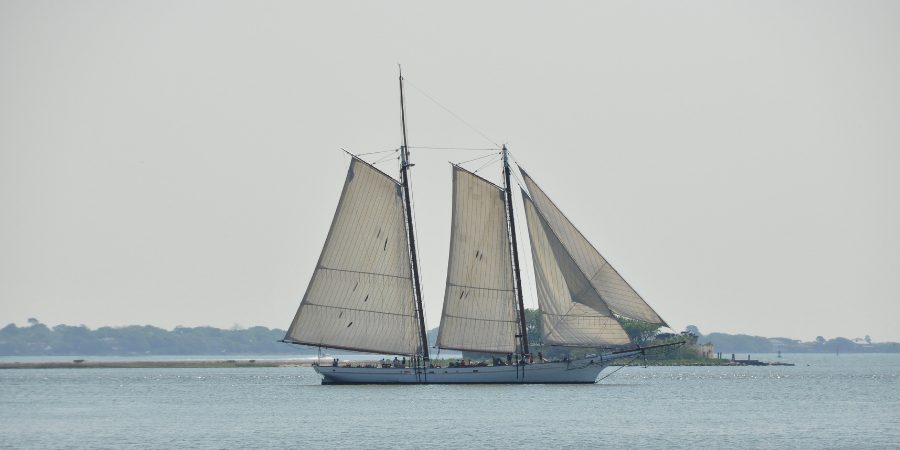
The main characteristic of the schooner is the masts are almost the same size, with the foremost mast sometimes being slightly shorter. The schooner is equipped with gaff sails on all masts, making it better equipped to handle strong seas.
This makes the schooner very versatile and well suited to crossing the ocean on the trade-wind routes as well as sailing coastal waters with varying wind directions.
Closing Thoughts
Because of the versatile design, many pleasure sailboats during the 19th century were schooner-rigged.
While a square topsail is the most common schooner sail plan, some have sprit rigged topsails that run diagonally across the mast. However, sprit rigging is inefficient in adverse weather as the sails are not easily lowered.
Conversely, sprit rigging excels in coastal waters where the sails can more readily catch the light winds that tend to blow higher up.
While a schooner is easy to sail, can handle various wind and water conditions and is probably the most magnificent sight on the sea under full sail, the draw back of the schooner is it is definitely not the fastest sailboat design.

- Sailing Resources

Download this cheat sheet to sail faster, cheaper and smarter.
Types of Sailboats: A Guide to Sailing Craft
There are many different types of sailboats. Each type has its own characteristics and uses, so it pays to be familiar with them before deciding which one is right for you.
Here’s a quick rundown of the most common types of sailboats:
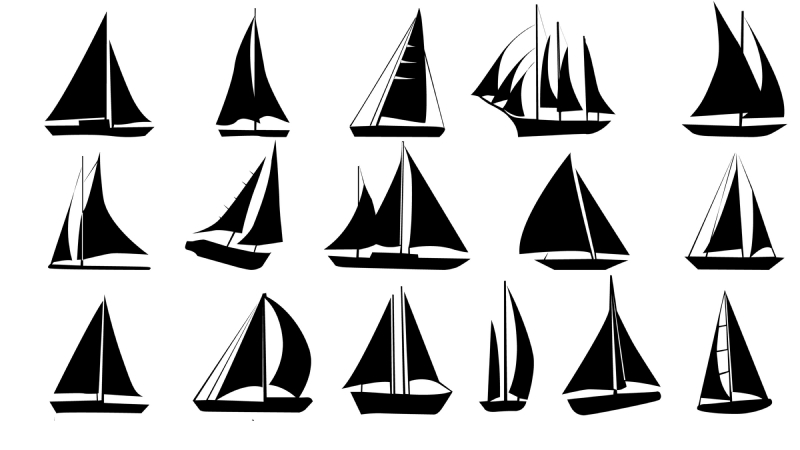
Types of sailboats by hull
- Monohull – A single-hull boat that has a flat bottom and straight sides, such as a sailboat or powerboat.
- Catamaran – An open boat with two parallel hulls and a deck connecting them.
- Trimaran – Similar to a catamaran but with three hulls instead of two.
Monohulls are probably the type of sailboat you’re most familiar with, and they’re also the most common. A monohull has one hull (duh), which means it’s shaped like a triangle or a rectangle.
These boats have been around since the very beginning of sailing, but they’ve undergone some pretty significant changes over time.
Today, modern monohulls come in all shapes and sizes—from small dinghies to massive yachts. Monohulls typically handle better than multihulls at high speeds because there is less surface area for air to flow across when wind pushes against them.
This makes them faster overall as well as easier to maneuver during races or other competitions where speed matters more than comfort
A catamaran is a vessel consisting of two hulls of equal size, connected by a frame or trampoline. The advantage of a catamaran over a monohull is that it has more stability, thereby reducing the need for ballast weight.
Catamarans are often faster than comparable monohulls because they can utilize the larger water surface area to make use of the wind.
Photo credit: Emma Dau
A trimaran is a multihull boat with three hulls in a triangular formation. The three hulls are connected by two parallel beams, called the trampolines or outriggers.
The center hull is the largest, and it houses most of the living space on board. The outer two hulls are smaller, and they serve as steering and propulsion.
Types of sailboats by their keels
Keels are the most common type of sailboat propulsion. They come in a few different varieties:
- Full-length keel – This is the most common and traditional form of keel, where the full length of the boat is submerged to provide stability.
- Fin keel – This type of keel has a fin at its tip that extends down below the waterline for greater stability at slower speeds.
- Bilge keel – A bilge-shaped or rounded bottom section forms this type of sailing vessel’s hull shape, providing extra stability in rough waters because it sits lower to the water than a full-length or fin keel does.
- Centerboard or dagger board boat – A centerboard or dagger board helps keep these boats upright by allowing them to slide up out of harm’s way when necessary; it also makes them more maneuverable than other types of sailing vessels due to their ability to pivot on an axis around its mast (or “mast”).
Full-length keel
A full-length keel is a common feature for sailboat hulls, and it’s one that you’ll see on many cruising sailboats.
This type of keel runs from the bow to the stern, completely encasing the hull in lead. It provides stability and resistance to leeway when sailing or motoring at low speeds.
It’s often used on boats that are designed for long distance cruising or racing (though not exclusively). A full length keel also allows you to take advantage of all available wind angles, giving your boat maximum speed potential as well as response time in rough conditions.
The main drawback of this type of keel is that it makes tacking more difficult, especially when there isn’t much wind or current pushing against your boat’s side.
If you’re trying to tack with a full-length keel on an empty lake during high winds and waves, don’t expect an easy transition back into forward motion once you’ve completed your 180° turn!
Fin keel sailboat
Fin keel boats are those with a fixed keel that runs along the centerline of the bottom of the hull.
his type of sailboat is generally considered to be easier to handle than other types of boats and they’re good for beginners.
he disadvantage is that they can over-steer when sailing close to the wind, especially in light winds. There are two major variations on this type:
- Fin keels have a bulbous end that acts as a stabilizing surface when going upwind or downwind, but it can cause problems if you try to sail directly into the wind (you’ll see what I mean if you look at pictures of fin-keeled boats).
- Finless spade rudder versions place their weight over the centerline instead, so they’re less affected by changes in wind angle than their finned counterparts—but they lack maneuverability in tight quarters or when sailing under outboard motor power alone.
Bilge keel sailboat
A bilge keel sailboat is one that has a keel that is set below the bottom of its hull.
This type of keel offers stability and control, which makes it ideal for smaller boats used for day sailing and non-competitive racing.
Bilge keels are used on many types of boats, including catamarans and trimarans; however, they are most often seen on small sailboats.
Centerboard or Dagger board sailboat
A centerboard is a retractable keel that is lowered down into the bottom of the boat.
The centerboard is lowered when sailing upwind, so that it can reduce drag on the hull. In this way, centerboards are similar to dagger boards and other retractable keels.
Centerboards are used on smaller boats because they make these boats lighter and more maneuverable than boats with fixed keels.
Because they’re lighter, you’ll also find that some centerboard boats are faster than fixed-keel boats—they have less drag from their hulls when moving through water at high speeds.
Many people use these small racing yachts for day trips or short coastal voyages due to their ease of handling in windy conditions near shorelines.
However, they’re not always suitable for longer journeys because their lack of stability makes them prone to capsizing or rolling over if there’s too much weight distributed towards one side of the vessel (i.e., if you put too much fuel in one side).
Types of sailboats by mast configuration
The configuration of the mast(s) is also important. There are three main types of masts: the mainmast, foremast and mizzenmast.
The mainmast is usually the tallest mast on a sailboat and carries most of its weight; it’s typically used as an additional support in heavy winds.
The foremast is just behind the mainmast in terms of height and generally has less sail area than either of them.
The mizzenmast sits further back than both these masts, but isn’t as tall as one or two feet high; this type generally supports light canvas-like sails that assist with steering when underway on open water without wind conditions favorable enough for full operation from other parts of your vessel’s structure (such as during calms).
A sloop is a sailboat with a single mast. The mainmast typically has a fore-and-aft rig, where there is one sail attached to it and it runs from front to back along its length.
The mast is directly behind the center of gravity of the boat (just where the keel runs).
t’s stepped at its forward end just ahead of amidships, which means that it’s slightly tilted down toward the bow; this helps keep any water that comes over it from running back down onto your deck.
Sloops can have either a fractional or full keel—or no keel at all! A fractional keel extends below but not far beyond amidships; such boats are often referred to as centerboard yachts rather than sloops when they lack mainsails (since they don’t look like traditional gaff rigs).
A full keel curves downward in front of amidships, then rises up again into an underwater hull extension called deadrise aft (which also increases speed by reducing drag), where you will find most modern sailing vessels located today because they offer greater stability without sacrificing performance or maneuverability as much as longer fin keels do.*
A cutter is a sailboat with two masts, which can be either a sloop or a ketch. The mainmast is taller than the shorter mizzen mast, and they are both located forward of the rudderpost.
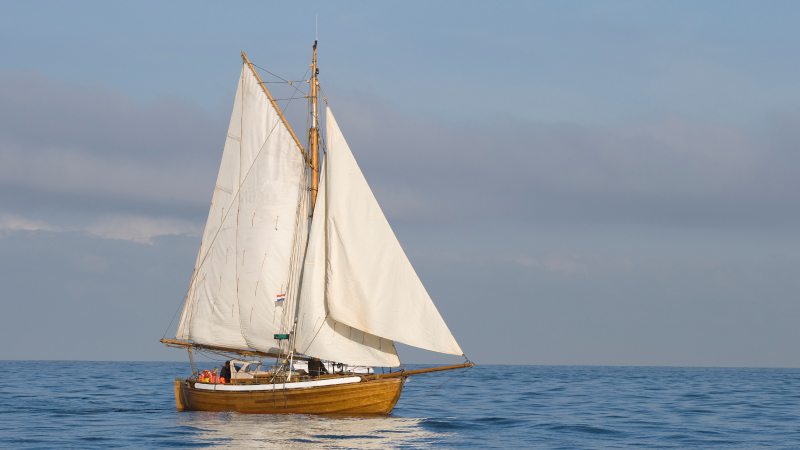
Cutters are among the most common types of sailboats. The design helps balance out heavy winds in all directions with its two sails and symmetrical rig (mainsail on one side, jib on the other).
You may also see this type of sailing vessel referred to as brigantine or barquentine depending on its rigging arrangement.
A ketch is a sailboat with two masts. The mainmast is larger than the foremast and has the same length as the hull.
This type of sailboat usually has a jib on the main, and a staysail or mizzen on its smaller topmast.
Ketch-rigged boats can be identified by their triangular shaped sails and their “V” shape when viewed from above.
A spinnaker is another type of sail that can be used on a ketch rig boat, but it is only used when sailing downwind at high speeds
A schooner is a sailboat with two (or more) masts. The foremast is usually shorter than the mainmast.
Schooners were first developed in the Netherlands and northern Germany in the 17th century.
The design was meant to improve on the square-rigged ships that were common at the time by increasing speed, maneuverability and cargo capacity.
Schooners became popular in North America in the 18th century due to their ability to navigate shallow waters and for their speed.
A yawl is a two-masted sailing vessel. The mainmast is stepped further aft than on a sloop, and the mainsail is hoisted from a boom. The jib will be hoisted from a bowsprit.
The catboat is a type of sailboat, with a single mast, usually a Bermuda rig, and a single headsail. It has a flat-bottomed hull and may be rigged as a sloop, cutter or yawl. The centerboard may be retractable or fixed.
The mainmast is often in the middle of the boat (centerboard amidships) but can also be near the bow (centerboard forward). Catboats are usually gaff rigged; if they have more than one jib on each side they are called cat schooners.
Photo Credit: Leonhard Peters
Other “types” of sailboats
A dinghy is a small boat used for racing, or for towing behind a larger vessel. The term is also used to refer to any small craft or boat. A dinghy may be propelled by oars, sails, or motors.
Sailing Dinghies were usually small undecked boats carried aboard larger ships as part of the ship’s complement and launched or lowered on deck when required.
While most people today reserve the term “dinghy” for small human-powered vessels such as inflatables that are suspended from another boat’s deck by ropes or cables (rather than being carried), this usage has not always been so clearly defined.
Photo credit: Ludomil Sawicki
A dory is a small, flat-bottomed boat with a single mast and a lug sail. It was used mainly as a fishing boat in the 19th century but has also been used as lifeboats on the Titanic and Essex. A dory was also used to rescue survivors of the sinking of the Essex in 1820.
A drift boat is a boat that’s designed to be sailed or rowed with no sail. It can be any size, but usually refers to small boats, often used for fishing.
A drift boat could also be a rowing boat with a centerboard, which is lowered during sailing to provide greater stability.
Alternatively, it may refer to a traditional sailing dinghy (a small boat) that has been rigged so that all sails are furled while under way and only used as oars when stopped or nearly stopped—with the exception of jibing maneuvers where they’re deployed briefly while tacking or gybing in order to keep heading straight into the wind until they can once again use their oars without fear of capsizing due to excessive speed during maneuvers.
Cruising sailboat
Cruising sailboats are designed for long distance travel. They are typically larger than day sailing boats but smaller than ocean racers. They can range from 20 feet to over 100 feet in length.
A daysailer is a small, simple sailboat. Daysailers are usually used for short trips on inland waterways and are often single-masted boats with a jib and mainsail. They’re also less than 18 feet long, making them easy to carry and launch at the dock.
Daysailers come in all shapes and sizes, but they tend to be either catboats or ketches that have been designed with easy handling in mind. A catboat has two flat sides, while a ketch has three flat sides—two parallel hulls connected by stays (or “booms”) that form an X shape across the boat’s cockpit (the area where you sit when sailing).
Both types of sailboats can be rigged to be sailed by one person or two persons together; however, yachtsmen typically prefer two people so that one person can steer while another person adjusts lines as needed during maneuvers such as tacking (turning into wind) or jibing (changing direction of travel by turning 90 degrees).
Racer-Cruiser
Racer-cruisers are fast, responsive and can race or cruise in shallow waters. These boats are highly maneuverable because they have a high center of gravity and lack ballast.
They’re good for racing but not so much for cruising: racer-cruisers don’t have much room below deck, which isn’t ideal for taking long trips with lots of gear onboard.
They’re also not recommended if you want to sail in light winds—the lighter the air pressure, the more difficult it becomes to keep your boat moving forward on course when it’s lightweight (due to its lack of ballast).
A skiff is a type of sailboat. It is usually small and light with a single mast located forward of the center of buoyancy (the place where the boat’s weight is centered). Skiffs are often used for racing or fishing, but they can also be used in shallow waters.
They may look like dinghies, but they don’t have as much freeboard (distance between the waterline and deck).
There are many different kinds of sailboats
As you can see, there are many different types of sailboats. It’s important to know the types of boats that are available so that when you’re shopping for one, you’ll have a better idea of what kind will be right for your needs and desires.
Mike Sellers

My Cruiser Life Magazine
Sailboat Types: Full-Guide
For generations, sailing has been a mode of essential transportation, a rewarding hobby, an active and competitive sport, and a lifestyle. Sailing appeals to all, and there are dozens and dozens of types of sailboats.
Small sailboats are perfect for kids to sail on, and massive sailboats are used to cross oceans in style. In between, there are daysailers, racers, and cruisers.
Table of Contents
- What Does a Sailboat Look Like?
Small Sailboats
Cruising boats, cruising catamarans, cruising trimarans, full keel boats, fin keel boats, centerboard keel.
- Hydrofoil Sailboats
A Purpose for Every Type of Sailboat
Faqs (frequently asked questions).
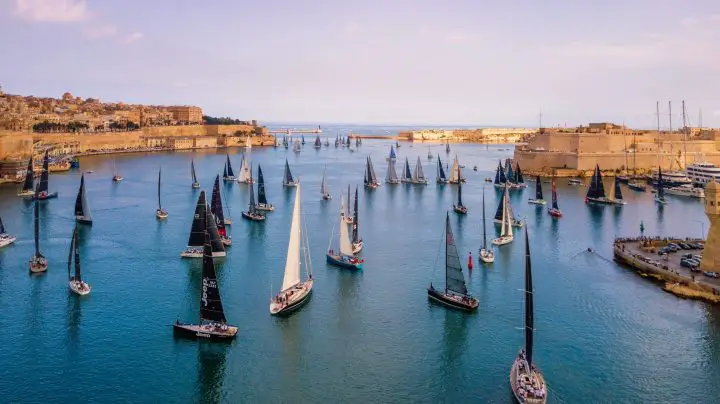
What Are Sailboat Types?
Sailboats are boats that are propelled by the wind. Sailboats use wind power instead of a motor or oars to move the boat. It should be noted, though, that nearly all modern sailboats have a motor as well. It comes in handy when docking in tight marinas and if the wind dies!
A sailboat has one, two, or three hulls. It has at least one mast, or tall vertical spar, that holds up one or more sails. The sails harness the power of the wind to move the boat forward.
To get started, here are some sailing boat types and terms to give you an idea of the sorts of boats that are out there.
- Dinghies — a small open boat, usually for only one or two people
- Daysailors — boats designed to go out for a day trip
- Cruising Sailboats — boats designed to travel long distances that have accommodations for their crew to live aboard a long term
- Sloop — the most common type of sailboat, with one mast and two sails (a jib and a mainsail)
- Ketch, yawl, or schooner — types of sailboats with two or more masts
- Monohull — a boat with only one hull
- Catamaran — a boat with two equal-sized hulls in the water that are connected together by a bridge deck
- Trimaran — a boat with three hulls in the water, the center of which is much larger than the outer two
What Does a Sailboat Look Like?
There are many different types of sailboats, so they look a little different from each other. The basics, however, are the same.
Each sailboat has at least one hull that sits in the water. Part of the hull is visible above the waterline. Part of the sailboat hull sits below the waterline.
The part beneath the waterline might be relatively small, or it can be quite large. The rudder, the mechanism used to steer the boat, is also underwater.
The cockpit is where the helmsperson sits and steers the boat. On small boats, the cockpit takes up the entire boat. Cruising boats have interior accommodations as well as a safe cockpit.
Sailboats have at least one mast and at least one mainsail. As you get to know the different types of sailboats, you’ll see many different hull and sail configurations.
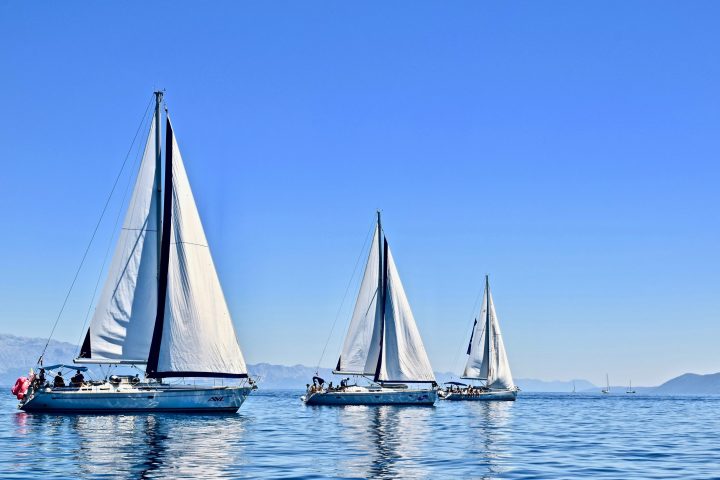
Different Types of Sail Boats
Sailboats come in all types of sailboat shapes and sailboat sizes . Sailboats can be classified by their hull shape, size, or sail plan. The sail plan is how many sails they carry on how many masts.
Hull shapes include monohulls, catamarans, trimarans, and sailing hydrofoils. A monohull has just one hull, a catamaran has two hulls, a trimaran has three hulls, and a hydrofoil lifts out of the water.
Sizes range from eight-foot sailboats to megayachts that are hundreds of feet long. Some sailboats are so small they are only suitable for one child who wants to go skimming across the lake. The largest pure sailing yacht in the world is the Black Pearl at 350 feet long (106.7 meters) long. Visit our Yacht vs Sailboat guide for a more definitive difference between the two and their sizes.
Sailboats also have different sail configurations or sail plans. For example, a sailboat with just one big sail on a forward-mounted mast is called a catboat. A boat with dozens of different sails on three masts is called a three-mast schooner.
Small sailboats are extremely popular and offer a lot of fun to the young and old. Most of the time, these boats are just used for daytime use in pleasant weather conditions. Kids often learn to sail in small monohull sailboats. Families might go for a picnic in a Hobie catamaran.
Yacht club members might race their 16-foot daysailors, while adventurous souls might take their 19-ft weekender and anchor in a calm cove for the weekend.
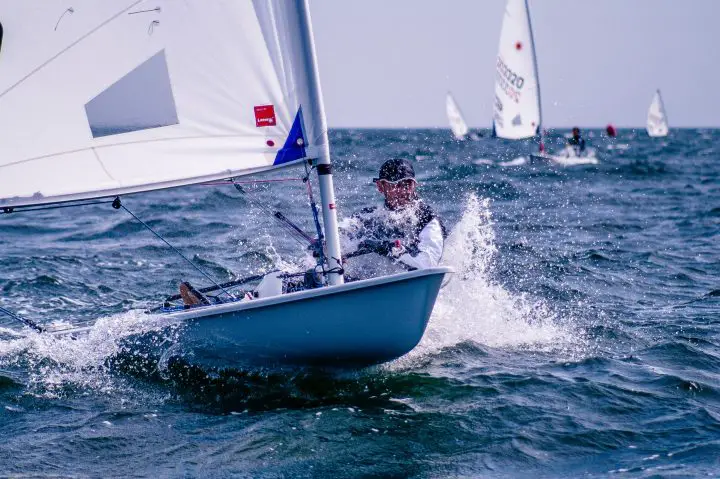
What is a Small Sailboat Called?
Small sailboats have different names, depending on the type of sailboat and the number of sail boat hulls. For example, the boat might be a monohull dinghy, small catboat, small catamaran, or daysailor.
Additionally, like every car on the road, every boat on the water is identified by its make and model. In small boats that are commonly raced, a certain make and model may set up a class of racing boats. Class racing means that all of the boats are identical, so the race is based solely on the skills of the skippers.
Sailing Dinghies
Kids and adults often learn to sail on sailing dinghies. Sailing dinghies can be as small as eight feet long. This small size makes it easy for kids to handle.
Some common sailing dinghies are Optis, Lasers, and Sunfish.
This size sailboat is also functional. They can be used to ferry sailors from their larger anchored boats to shore. The small size also helps sailors easily store their dinghy on larger boats. The word dinghy is often used to refer to any small boat used as a tender for a larger vessel, even if the tender is a motorboat.
Cat Rig Boats
A cat rig boat, or cat boat, is a type of sailboat that usually just has one large mainsail and a forward-mounted mast. Many smaller dinghies and training boats are catboats. A catboat has a free-standing mast with no standing rigging.
Small Catamarans
A catamaran is a boat with two hulls. The Hobie brand is synonymous with small catamarans, which are popular with families looking for a fun hobby. Hobie Cats are seen on the sand at beach resorts all over the world—they’re safe, fun, and fast.
Catamarans are faster than monohulls, and these boats are fun to race. Small catamarans are often used by families that live on the waterfront. Their lightweight makes them easy to drag to the waterfront and launch.
Small catamarans are also popular on beaches. Many beach resorts offer Hobie cats for rent. Small catamarans are between 12-20 feet in length. The hulls are joined only with spars and netting, so these fast and light open boats are not set up to carry a lot of people or supplies.
Daysailors are the ultimate fun boat. As the name implies, this type of sailing boat is used for day sailing. These boats are usually between 12 to 20 feet long. Some use these smaller boats for racing or overnight camping, but most sailors use daysailors for a leisurely sail.
Small Sailboats with Cabins
While most small sailboats just have a large open cockpit, several small yacht types have cabins. These cabins offer a chance for sailors to use a porta-potty or get out of the sun. Some small sailboats even have sleeping accommodations for overnight stays.
An excellent example of this is the Cape Dory Typhoon Weekender. This small sailboat is known as “America’s Littlest Yacht.” Down below, there are two small bunks for sleeping and enough space to have a small stove and a porta-potty. Most owners don’t stay aboard long-term, but the cabin is a useful place to stow items while sailing or to hide during a rainstorm.
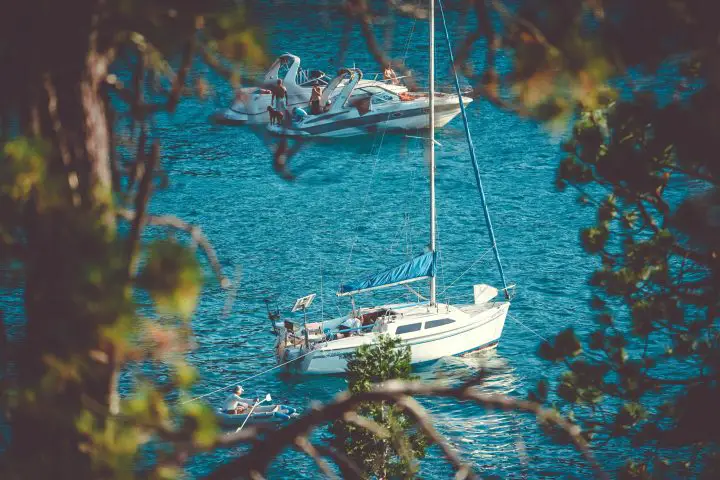
Cruising boats are boats that are capable of traveling long distances. Cruising boats have sleeping accommodations, cooking facilities, and bathroom facilities. These boats are like RVs for the waterway.
Cruising boats offer sailors the chance to live on their boats while sailing. Like RVs, cruising sailboats travel to different ports of call. Cruising sailboats are one of the more popular types of sailing boat. They offer adventurous sailors the chance to enjoy sailing as a sport while seeing new things.
Cruising boats are usually 30 to 50 feet long. Most cruising couples prefer a boat that is around 40 feet long since this provides enough space to live comfortably and enough storage space for all of their gear.
Monohulls are very popular cruising boats. These boats offer good storage, are safe, and are easy for a couple to handle together. Monohulls have different types of sail configurations.
Cruising Bermuda Rigged Sloops
Most monohulls are Bermuda rig sloops. This sail plan features one mast with a mainsail and a headsail. Bermuda rig sloops are easy to single-hand and very versatile. How many sails does a sloop have? A Bermuda sloop flies two sails at a time, which are the mainsail and a headsail.
However, the boat might have other sails onboard. For example, the captain might take down the jib in light winds and use a bigger genoa to capture more wind power. During a downwind sail with light winds, the captain might rig a large spinnaker, which looks like a huge kite, to keep sailing even in little wind.
Even within the sloop category, there are many variations in the design. A masthead sloop is one whose forestay (headsail) goes all the way to the top of the mast. In contrast, a fractional sloop’s forestay connects at some point lower. So a 3/4 fractional rig has a headsail that only goes up three-quarters of the way to the top.
Riggers and boat designers have a lot of tools in their toolbox from which they can make a boat faster or more user-friendly. The type of rigging and sail plan a boat is equipped with offers it performance improvements as well as functionality.
Cruising Cutter
A cutter is a sailboat with one mast, one mainsail, and two sails forward of the mast. The sail at the front of the boat is the jib, genoa, or yankee depending on its size and cut. The next sail in, the inner headsail, is called the staysail. Island Packets are popular boats with this sail plan.
Cutters are popular choices as cruising and bluewater cruiser boats because the staysail provides the skipper with many different sail options. They could fly all three sails fully, or they could fly a small partial mainsail and just the staysail for heavy winds.
Cruising Ketch With Mizzen Sail
Some cruising monohulls are ketches. A ketch can be easily identified by its two masts. The forward mast is the main mast with a mainsail. The aft mizzen mast is shorter and has a mizzen sail. This sail plan can make it easier to carry a big sail area and configure the sails for various sailing conditions.
A boat with more than one mast is called a split rig because the rig is split between two shorter masts instead of all mounted on one tall one. The advantage of a split rig is that there are more sails, each of which is smaller. That makes them easier to handle, and important consideration when you are sailing alone or with only one other person.
Cruising Yawl
A yawl is similar to a ketch and has two masts. However, the mizzen mast on a yawl is aft of the rudder post, whereas it is forward of the rudder post on a ketch. This mizzen mast location is even further back than a ketch’s. Yawls are one of the less popular types of sailboats. However, like the ketch, they offer diverse sail options and can keep sailing in many different types of weather.
On both ketches and yawls, the mizzen mast is shorter than the main mast. If the two masts are of equal height, or the forward mast is shorter, then you are looking at a schooner.
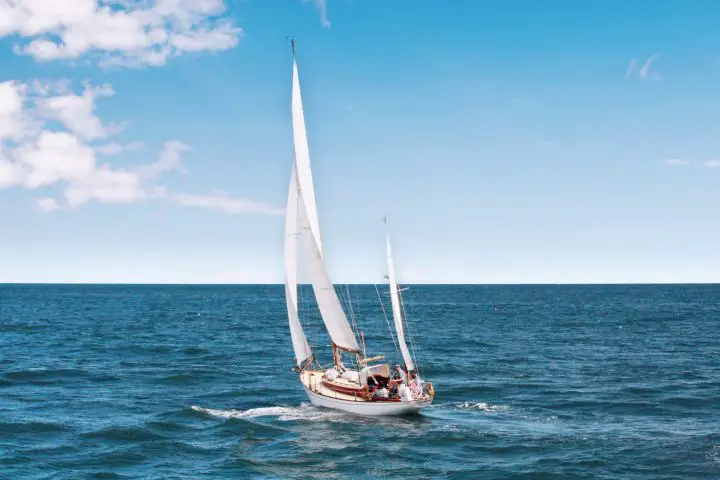
Cruising catamarans are one of the most popular classes of sailboats right now. This type of sailing boat has two hulls and offers sailors speed, space, and comfort. A cruising catamaran is usually between 40 and 60 feet long and 20 to 30 feet wide. The additional width offers cruise sailors huge amounts of space.
Cruising catamarans have excellent storage space and ample living accommodations if you intend to living on a boat . These boats are popular with couples and families and are often used to sail around the world on circumnavigations.
Cruising catamarans are usually fractional sloop rigs. They have one mast, a large mainsail, and a jib or genoa. In general, these boats are designed to be easy to sail and minimize complications.
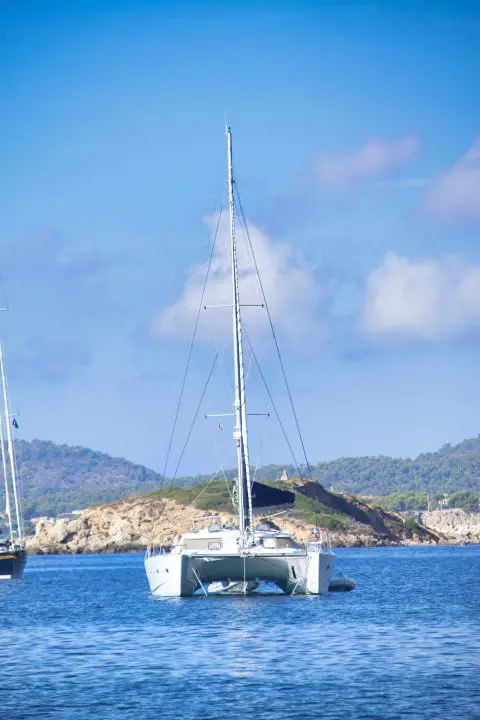
Trimarans are a type of sailboat with three hulls. Trimarans are known to be fast and are popular with racing sailors. However, they are also gaining popularity as cruising boats. These boats usually have fewer accommodations than cruising monohulls and catamarans. However, more modern trimarans like the Neel Trimaran have luxurious living spaces.

Types of Keel
Another way to classify the different types of sailing boats is by looking at the boat’s keel type. You can easily get an idea of different keel designs by walking around a boatyard. When a sailboat is in the water, it is hard to tell the shape of its keel.
The keel is the bottom part of the hull and is underwater. The keel is structurally essential. The keel’s weight helps the boat sail evenly and uprightly. The force created by the water moving over the keel counteracts the effects of the wind on the sails.
So a keel does two jobs for a sailboat. First, it provides a force that allows a sailboat to sail into the wind. Second, it provides stability. If storm-force weather conditions cause a monohull boat to roll, the weight in the keel will help the boat right itself.
Many older cruising boats had full keels. The keel shape runs the entire length of the boat. A full-keel boat is strong and easy to manufacture. Full-keel boats often have deeper drafts. The boat’s draft refers to the amount of water it needs to float. Full-keel boats can’t go into the shallow anchorages that catamarans or swing-keel boats can access.
Captains often report that full-keel boats are harder to maneuver in tight places such as marinas. Full-keel boats lack quick maneuverability. They have a reputation for being slower than more modern designs, but they make up for this by providing a very comfortable and safe ride in rough weather.
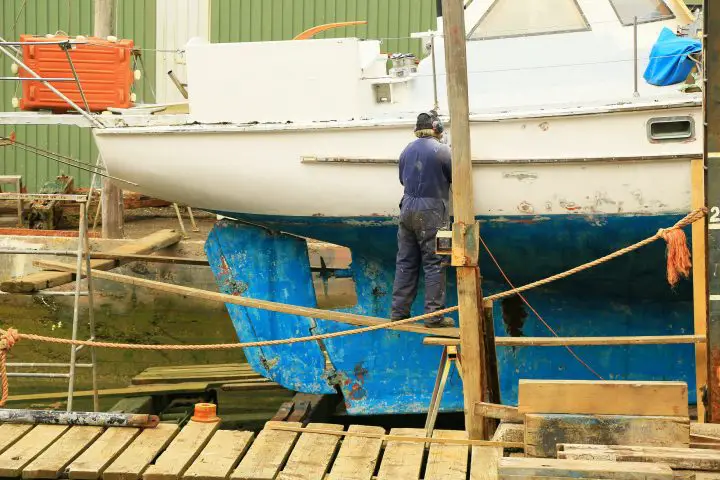
A boat with a fin keel has a smaller underwater profile than a boat with a full keel. This smaller keel resembles a fish fin. Captains find fin keel boats easier to maneuver. Fin keels use their shape to create very effective forces underwater. That makes them very good at countering the forces on the sails, meaning that fin keels sail upwind very well.
A boat with a bulb keel has a torpedo-shaped bulb on the bottom of a fin keel. Bulb keels offer improved stability. Bulb keels have shallower keels than a fin keel boat. The bulb also lowers the center of gravity in the boat, making it more stable overall.
A wing keel features a keel with a small wing on either side of the keel. Viewed from above, the keel looks like it has a set of small airplane wings.
Similar to a bulb keel, wing keel boats often have a shallower draft than fin-keel boats. However, the additional shape causes drag and can reduce sailing performance in some circumstances.
A centerboard is common on small daysailors that are launched and retrieved from trailers. Deep keels make getting those boats in and out of the water difficult. By chopping off the keel, you can make a sailboat as easy to launch as a powerboat.
Related: Best Trailerable Sailboats
But of course, a sailboat needs to have a keel. A centerboard is a simple swinging fin keel that can be raised or lowered. This provides some excellent benefits if the sailor on board likes to explore areas with shallow water.
Many bigger boats have centerboards, too. A boat with a centerboard can be seen as the best of both worlds. A centerboard boat has a fixed shallow draft keel. However, the captain can deploy the centerboard when sailing in deeper waters. The centerboard adds depth to the keel and offers increased stability and performance.
A modification of the centerboard is the swing keel — a ballasted keel that can be retracted like a centerboard . These are rare. They’re used on large cruising boats where the crews want the option of accessing shallow waters. In England, this type of boat is used and can be dried out when the tide goes out.
Racing Sailboats
Yacht racing is a popular sailing sport. It’s a great way to get out on the water while competing. In fact, racing is a great way for sailors to hone their sailing skills. Sailors have to pay close attention to weather conditions and manage their sails effectively to maximize their speed.
Sailors can race any boat with sails. Kids race sailing dinghies against each other. Club racers sail daysailors or catboats. Catamarans and trimarans are also popular race boats. Several classes of boat races in the Summer Olympics.
Hydrofoil Sailboats
A hydrofoil is a unique and modern type of racing sailboat. A hydrofoil can be a monohull, catamaran, or trimaran. A hydrofoil has wing-like foils on the hull’s underside.
As the sailboat speeds up, the hydrofoils lift the hull out of the water, and the hydrofoil sailboat almost appears to be flying above the water.
Because the hull is now out of the water, drag, and resistance are minimal, and the sailboat can sail even faster. For example, a dinghy that usually goes four knots can accelerate to 12 knots when fitted with a hydrofoil.
Most hydrofoil sailboats are catamarans and trimarans. The added width of these multihull sailboats gives the hydrofoil sailboat more stability.
Traditional Sailboats
Traditional sailboats are the type of sailboats used to transport people and goods before modern transportation options were available. Before the railway, cars, and airplanes, a tall ship sailboat was used to ship cargo and people across oceans and from port to port.
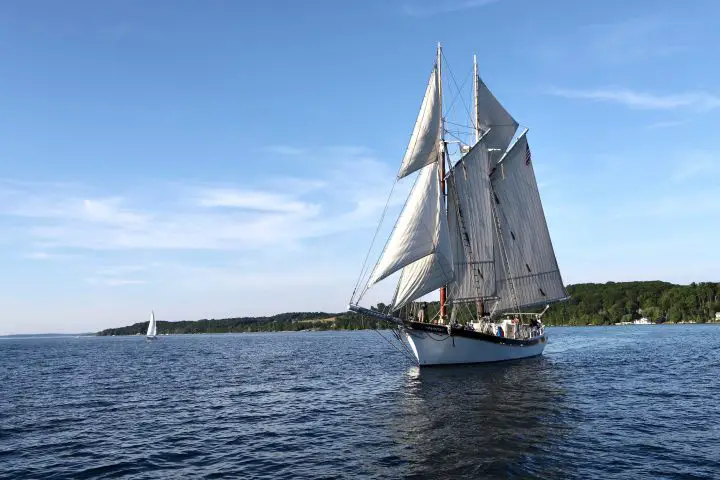
A gaff rig refers to the gaff, which is the upper spar on a square-shaped sail. Gaff rigs can be used with any mast configuration, but this feature is usually seen on traditional boats like a catboat, tall ship, or schooner.
A schooner has at least two masts. They are different from other mast configuration designs with two spars in that both masts are equal in height, or the forward mast is shorter. Schooners are faster than most traditional boats and were often used to transport perishable goods such as fruit.
Schooners were also popular race boats in the early 20th century. For example, first America’s Cup races were won by schooners.
Today, schooners are usually used as charters for vacations or youth sail training programs. But there are a few cruising boats out there that feature schooner rigs.
Any way you divvy it up, there are tons of different types of sailboats out there. With a little research and a little looking, you’re sure to find one that suits your style and boating plans.
What are the classes of sailboats?
Sailboat styles can be classified by hull type, use, or sail plan. The types of sailboat hulls include monohulls, catamarans, and trimarans. You can also categorize the kinds of sailboats by their use. For example, sailors use their boats for daysailing, cruising, and racing. Finally, different kinds of sailboats have different sail plans. A sailboat might be a sloop, ketch, yawl, catboat, or schooner. The term “classes” has a particular meaning in sailing, however. Class racing is the competitive racing between boats of the same make and model—boats of the same “class” or of “one design.” There are hundreds of different classes of sailboats out there. Some of the most popular classes include the Laser and Sunfish classes.
What is a small 2 person sailboat called?
A small two-person sailboat is a dinghy. These small boats are fun to sail on protected waters. Many kids learn to sail in a sailing dinghy. There are dozens of makes and models of sailing dinghies available, some are used in Olympic sailing racing while others are just rowboats with sail rigs attached.
Matt has been boating around Florida for over 25 years in everything from small powerboats to large cruising catamarans. He currently lives aboard a 38-foot Cabo Rico sailboat with his wife Lucy and adventure dog Chelsea. Together, they cruise between winters in The Bahamas and summers in the Chesapeake Bay.
Leave a comment
Your email address will not be published. Required fields are marked *
Save my name, email, and website in this browser for the next time I comment.
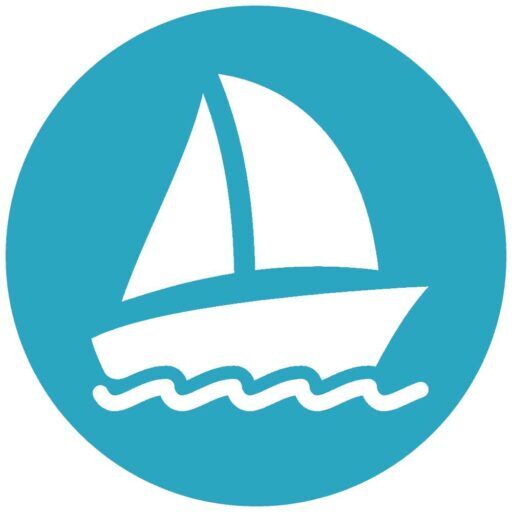
WaterCraft 101
Your guide to fun on the water!
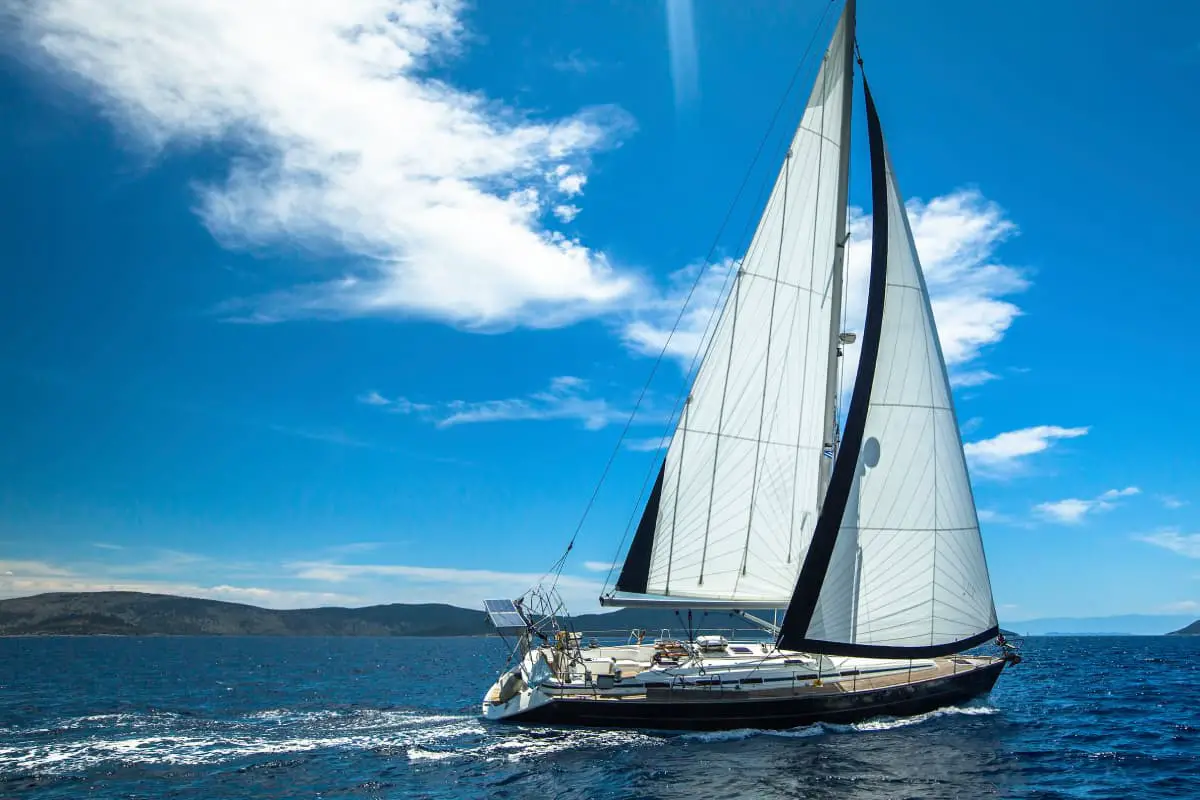
Why Do Sailboats Have Two Sails? (Explained)
If you’ve ever been sailing or watched a regatta, you’ll know that boats typically have two or more sails. It’s uncommon to see them with less than that. But what’s the reason behind this?
Sailboats have two sails to improve the boat’s maneuverability, balance, speed, and ease of handling. The front sail is called the jib, while the one behind it is the mainsail. Some boats have more than two sails to increase their stability and speed even further.
The way sailboats work is very interesting, so you’ll want to learn more! In this article, I’ll give you some in-depth explanations for why sailboats have two sails. So keep reading, everything you need to know is below.
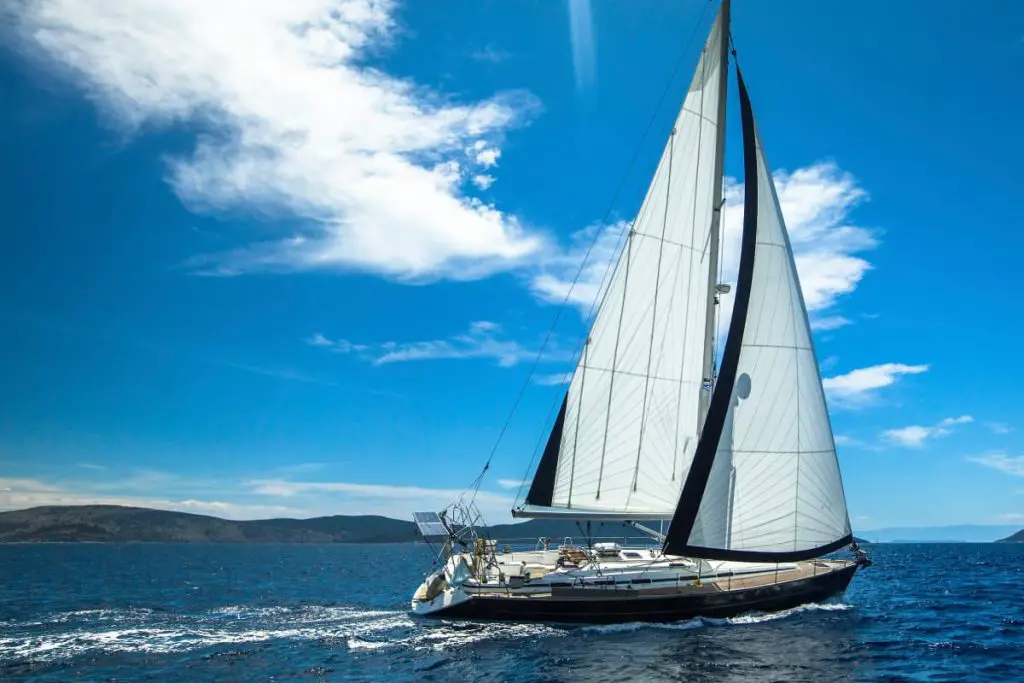
How Does Having Two Sails Help Sailboats?
It’s rare to see a sailboat with only one sail, and this might make you wonder what the science is behind this phenomenon. So, how does having two sails help sailboats?
Having two sails (a mainsail and a jib) helps sailboats by allowing the sailor to better maneuver the sailboat through the water, easily increase the boat’s speed, and have better handling over the boat overall. In short, having two sails offers improved control over the boat.
With all these benefits, sailors can handle their boats with ease. I’ll discuss these points in more detail below:
Two Sails Offer Greater Maneuverability
Many beginner sailers make the mistake of assuming that sailboats move because the wind exerts a force on the sails.
This is only partly true because when a boat has more than one sail, the wind’s current is split along the mast into two rough wind streams on either side of the sail. The space in front of the sail will have a low-pressure area, while the wind will create high pressure behind it. The pressure difference exerts a force on the sails that propels them forward.
The sail will move in the wind stream direction with the lowest pressure by being dragged forward.
The lowest-pressure wind stream gradually stabilizes, resulting in the wind moving faster on that side of the sail. This causes the sailboat to move because the wind is pulling the sail, and it is the same concept as an airplane’s wings creating lift .
Having Two Sails Allows for Increased Speed
A sailboat speeds up when a sail is perpendicular to the wind, with the wind blowing into the sail.
However, having two or more sails can help your sailboat go even faster. Some wind gets caught on your mainsail and some blows around it when you’re out on the water. The air that moves around the mainsail contributes to your sailboat’s acceleration, which you could further increase by adding another sail.
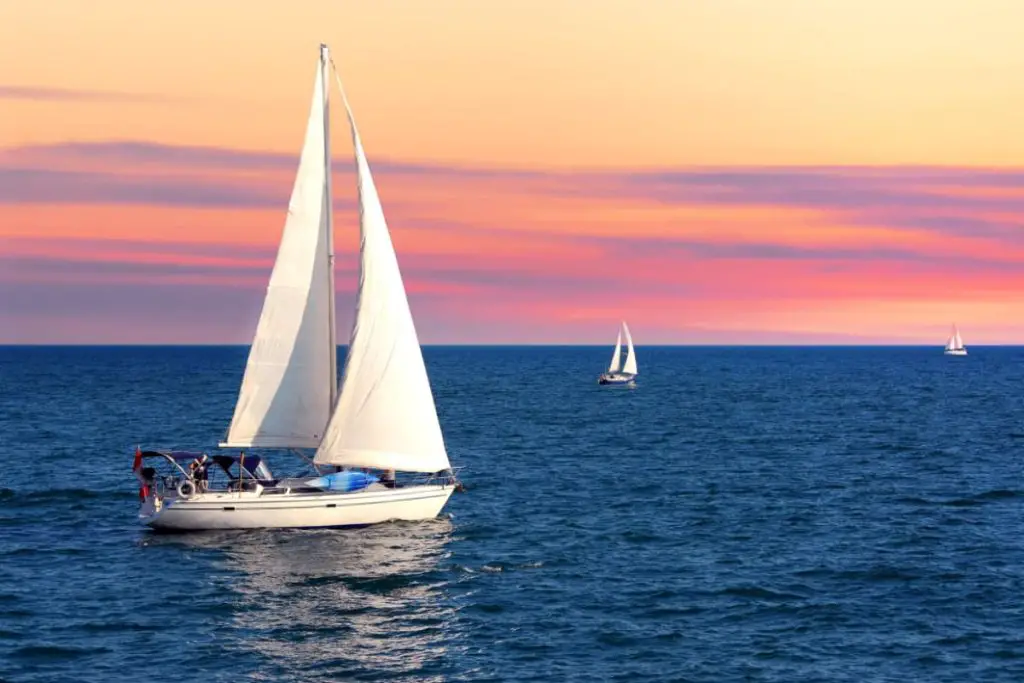
Two Sails Increases the Ease of Handling
When boats have two sails, you can handle them much easier. This is because all boats have a pivot point located behind the mast. Most of the mainsail’s surface area is behind the pivot point.
If you were to sail your boat with only the mainsail, the wind’s force behind the pivot point would be greater than the force in front of it. The sailboat would then tend to turn in the wind’s direction.
In a strong wind, sailing with only the mainsail would mean that your rudder wouldn’t be powerful enough to steer the sailboat, and you would need to rely on the mainsail to steer your boat.
However, adding a jib to your sailboat would balance out the force from the mainsail, making it easier for the sailor to handle and making the boat more stable.
A sailboat’s keel helps keep it upright by compensating for the wind’s sideways forces. However, you adjust the jib slightly to move the sailboat in another direction, proving that having two sails helps you control your sailboat more effectively.
What Are Boats With Two Sails Called?
Boats with two sails are called cutters or sloops. Both have a mast with two sails, but a cutter has two foresails, while a sloop has a mainsail and a jib. Ketches are also sailboats but feature more than one mast with multiple smaller sails.
There are a variety of sailboats out there. Below is some more information about these three sailboat varieties:
Cutter: Sail Configuration
Like sloops, cutters have a single mast. Unlike sloops, cutters usually have two headsails. Cutter headsails tend to have a lower center of gravity than the jib sail of sloops, giving cutters more stability and better control in rough conditions. Cutters are commonly seen in Bermuda-rigged or gaff-rigged configurations.
Regardless of the configuration, cutter rigging is more complex than the rigging of most sloops. This makes them a bit more challenging to handle single-handed.
Sloop: Sail Configuration
When most people think about sailboats, this is the one they see in their minds. The classic single mast, double sail configuration with a Bermuda rig is fun to sail and reasonably easy to control. The high-profile mast does, however, make them easier to capsize in rough conditions.
While the Bermuda rig is the most popular configuration for sloops, it is not the only one. Some sloops feature fractional sloop rigs or specially designed racing rigs. Fractional sloop rigs offer more stability options and usually are preferred for extended offshore use. As you may have guessed, Racing rigs are designed for speed and maneuverability.
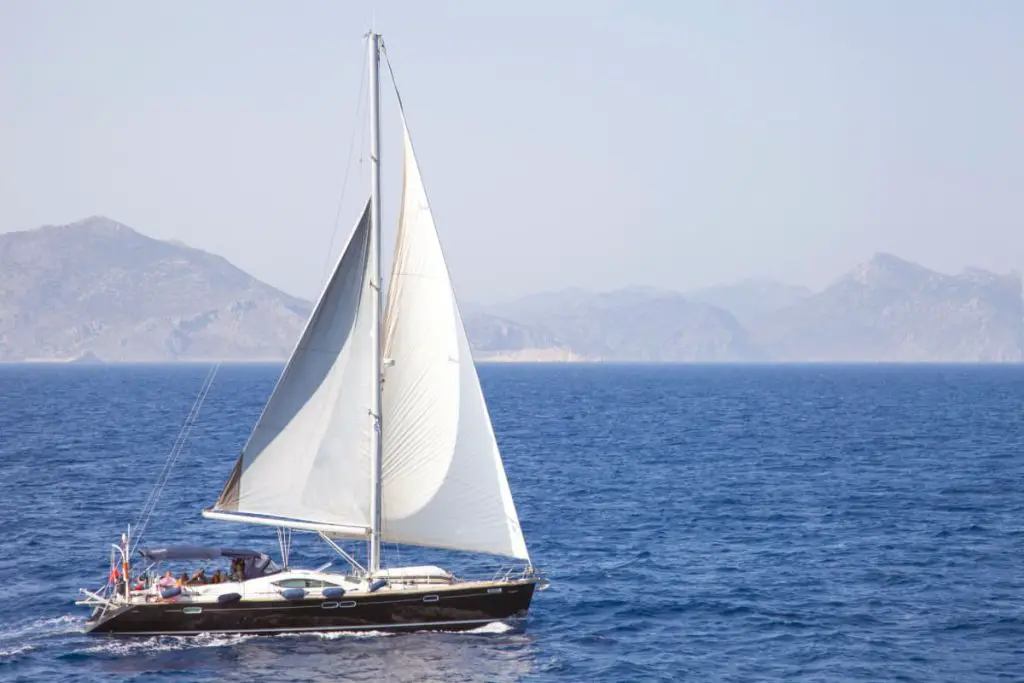
Ketch: Sail Configuration
We’ll now take a short visit to touch on a type of sailboat with more than one mast. Ketches feature a taller mainmast near the front of the boat and a shorter mast near the rear. The shorter mast is called the mizzenmast.
This split rig divides the sail plan into smaller components than a single mast sailboat. A ketch can be either Bermuda-rigged or gaff-rigged. Ketches usually have smaller sails and shorter masts than sloops or cutters, making them easier to control in difficult weather conditions.
Though generally slower than their single mast cousins, sailors who prefer safety over speed tend to favor ketches for their durability and the peace of mind that comes from having a second mast.
Yawls are closely related to ketches, yet the mizzenmasts are set further back.
Why Do Sailboats Have Two Sails – Final Thoughts
Sailboats have two sails as they allow the sailor to:
- Enable better maneuverability
- Increase their traveling speed
- Improve the sailboat’s ease of handling
Sailboats with two sails and one mast can be either sloops or cutters.
Bryan is a Las Vegas resident who loves spending his free time out on the water. Boating on Lake Mohave or Lake Havasu is his favorite way to unwind and escape the hustle and bustle of the city. More about Bryan.
Similar Posts
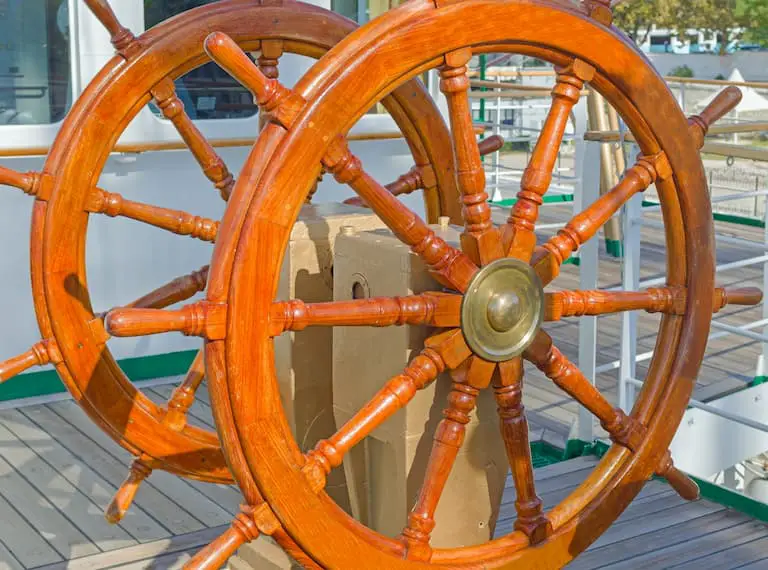
Why Some Sailboats Have Two Helms (Dual Helms Explained)
While most sailboats have a single helm with a steering wheel in the center, some larger sailboats or racing boats may have two helms. So, why do these sailboats have double helms? Are there any practical benefits of two helms on sailboats? Some larger sailboats have two helms as it helps with steering from different…
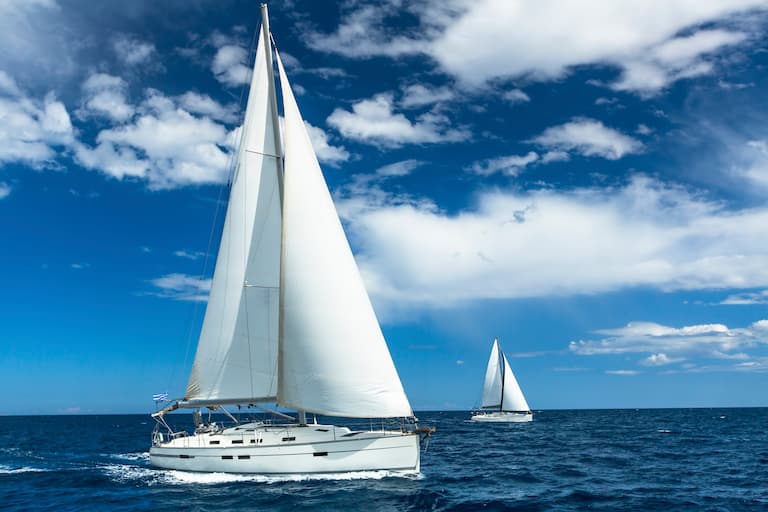
How Tight Should Sailboat Lifelines Be? (Need to Know!)
A lifeline is a safety device frequently found on sailboats and on construction sites. It’s composed of wire and stanchions, which are secured around the ship’s perimeter to prevent passengers from being thrown overboard or accidentally falling. But how tight should they be? Sailboat lifelines should be tight enough so they only stretch about two…
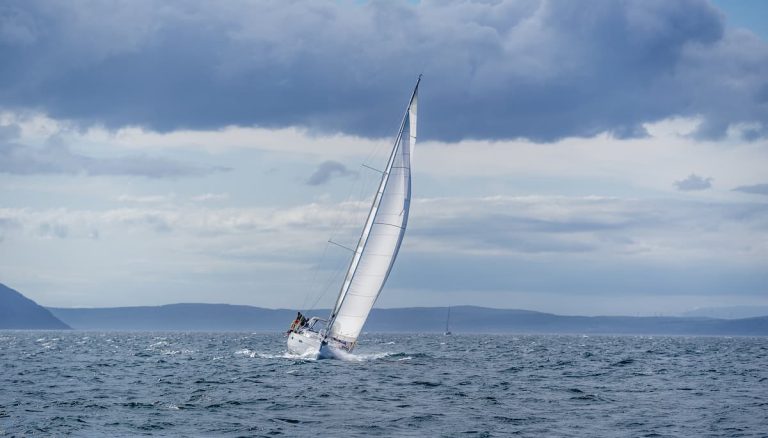
What To Do When a Sailboat Is Heeling Too Much (Explained)
Sailing is a fun activity for many people, but it comes with the innate prerequisite of being on the water rather than on stable ground. Aspiring captains must learn how to navigate and operate a boat while it rocks around in the water, which means dealing with things like heeling (i.e., leaning too far to…
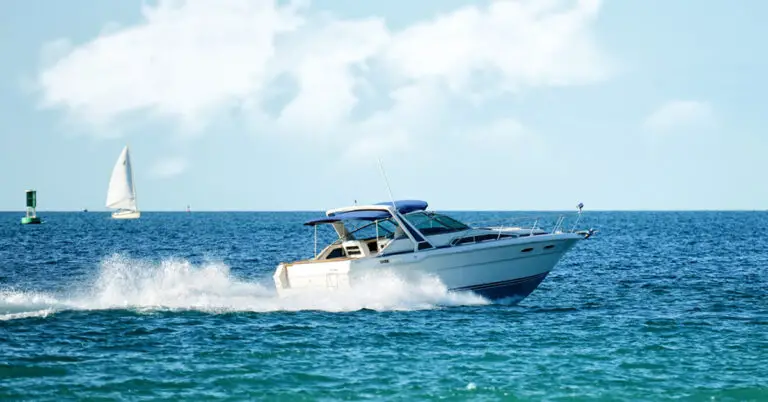
Sailboat vs. Powerboat: Which Is the Give-Way Vessel? Understanding Navigation Rules on the Water
Navigating the waters is an exciting adventure, whether you’re at the helm of a sleek sailboat or commanding a powerful motorboat. However, along with this thrilling journey comes the responsibility of understanding and adhering to the marine navigation rules, specifically those concerning the right of way or the “give-way” vessel. This aspect is vital to…
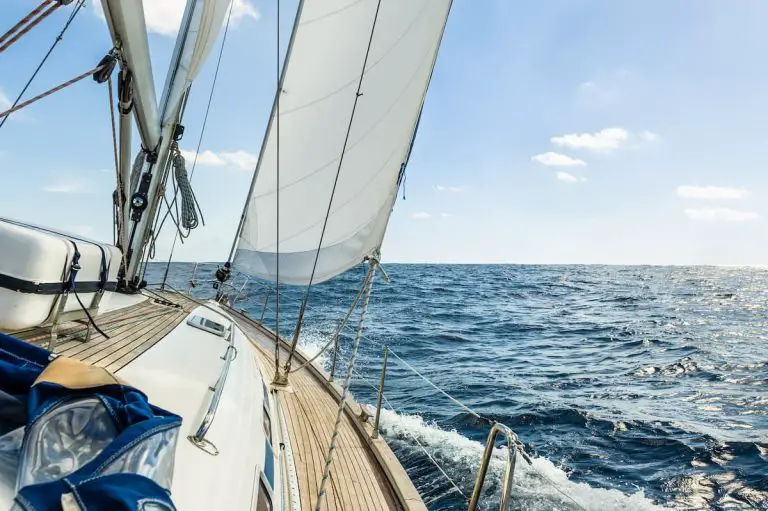
How Far Can a Sailboat Heel? (The Simple Answer)
Heeling is when a sailboat leans to one side, which can occur naturally or deliberately. When done deliberately, proper heeling enables a sailboat to travel faster. This, in turn, begs the question of how far a sailboat can heel? The optimal heeling range for sailboats varies by model and preference but usually sits between 10…

What Is A Sailboat Mast?
A sailboat mast is one of the most defining features of a sailboat (along with the sails of course!) You can immediately tell that a boat is a sailing boat when you spot the tall mast sticking out of the hull.
But why do sailboats need a mast? Having lived on a sailboat for years now I’ve never really questioned the need for a mast. It’s such an integral part of the boat that I just sort of forget it’s there!
When our friends recently lost their mast due to a rigging failure it got me thinking – why do sailboats need a mast and what function (aside from holding up the sails) do they actually play. It turns out, quite a lot!
We’re going to dive into the fascinating world of sailboat masts, exploring different rigs, mast materials, and the different functions that masts play. It’s important stuff if you want to go sailing, and a lot of it I should have known sooner!

As an Amazon Associate, we earn from qualifying purchases. We also earn from other affiliate programs. This means we may receive a small commission on products purchased through our links at no extra cost to you.
Table of Contents
Why do sailboats need a mast, parts of the mast, what materials are masts made from, single mast rigs, sailboats with two masts, sailboats with three masts, how to look after your mast.

A sailboat mast is a vertical, upright structure that supports the sails of a sailboat. It is a crucial component of the boat’s rigging system and plays a key role in harnessing the power of the wind to propel the vessel. Typically located in the center of the boat, the mast extends upward from the deck or hull.
The height of the mast varies depending on the size and type of the sailboat, directly impacting the sail area and overall performance of the boat.
Together with the boom (a horizontal spar attached to the bottom of the mast), the mast allows sailors to control the shape and orientation of the sails, optimizing their efficiency in different wind conditions.
The design and configuration of the mast can vary depending on the type of sailboat, such as a sloop, cutter, ketch, or schooner.
Sailboats require a mast primarily to support the sails.
It holds the sails in an elevated position, allowing them to catch the wind effectively. Without a mast, the sails would lack the means to be raised and positioned to harness the power of the wind.
There are a few other important jobs that the mast plays:
Control and Manipulation of Sails: The mast, along with the boom (a horizontal spar attached to the mast’s lower end), enables sailors to control and manipulate the sails.
By adjusting the angle and tension of the sails through the mast, sailors can optimize their performance according to wind conditions and desired boat speed.
This control allows for maneuverability and efficient use of wind power.
Structural Integrity: The mast contributes to the overall structural integrity of the sailboat. It helps distribute the loads and forces exerted by the sails, rigging, and masthead components throughout the boat’s hull and keel.
The mast’s design and construction ensure stability and strength, allowing the boat to withstand the forces generated by the wind.
Attachment Points for Rigging: The mast provides attachment points for various rigging components, including halyards (lines used to raise and lower the sails), stays (wires or rods that support the mast in different directions), and shrouds (wires that provide lateral support to the mast).
These rigging elements are essential for properly tensioning the sails and maintaining the mast’s stability.
Height and Visibility: The mast’s height contributes to the sailboat’s visibility, allowing other vessels to spot it more easily, particularly when sailing in congested waters. The mast’s presence also serves as a visual reference for determining the boat’s position, orientation, and distance from potential hazards.
While the mast’s primary purpose is to support the sails and enable control over their position, it also plays a significant role in maintaining the structural integrity of the sailboat and enhancing its visibility on the water.
Basically, the mast is pretty darn important!

Along with a million other confusing sailboat terms , the mast has lots of different parts too. A sailboat mast consists of several distinct parts, each serving a specific function. Here are the different parts commonly found on a sailboat mast:
- Masthead: The masthead is the topmost section of the mast. It often includes attachment points for various components such as halyards (lines used to raise and lower the sails), the forestay (the wire or rod that supports the front of the mast), and other rigging elements. The masthead may also house instruments like wind vanes or antennas.
- Spreaders: Spreaders are horizontal bars attached to the mast, typically positioned at specific intervals along its length. They help support the rigging wires and prevent excessive sideways bending of the mast. The position and angle of the spreaders contribute to the proper alignment and tension of the rigging.
- Shrouds: Shrouds are the wires or cables that provide lateral support to the mast. They connect the mast to the sides of the boat, helping to stabilize the mast and distribute the loads generated by the sails. Shrouds are typically tensioned using turnbuckles or other adjustable fittings.
- Backstay: The backstay is a cable or wire that provides support to the rear of the mast. It helps counterbalance the forces exerted by the forestay and the mainsail, preventing the mast from excessively bending forward. Adjustable backstays allow for tuning the mast’s rigidity based on wind conditions and sail trim.
- Halyard Sheaves: Halyard sheaves are small wheels or pulleys located at the masthead or lower down the mast. They guide halyards, which are lines used to raise and lower the sails. Halyard sheaves minimize friction, allowing smooth and efficient hoisting or lowering of the sails.
- Gooseneck: The gooseneck is a fitting that connects the boom to the mast. It allows the boom to pivot or rotate horizontally, enabling control over the angle and position of the mainsail. The gooseneck may include a pin or other locking mechanism to secure the boom to the mast.
- Mast Step: The mast step is the base or fitting where the mast rests and is secured to the deck or hull of the sailboat. It provides stability and distributes the loads from the mast to the boat’s structure.
These are some of the primary parts found on a sailboat mast. The specific configuration and additional components may vary depending on the sailboat’s design, rigging system, and intended use.

I was surprised to learn that sailboat masts are commonly made from several different materials, each offering its own advantages in terms of strength, weight, and flexibility.
The choice of material depends on various factors, including the type and size of the sailboat, desired performance characteristics, and budget.
Here are some of the materials used for sailboat mast construction:
Aluminum is a popular choice for sailboat masts due to its favorable combination of strength, lightweight, and corrosion resistance. Aluminum masts are relatively easy to manufacture, making them cost-effective. They offer good stiffness, enabling efficient power transfer from the sails to the boat.
Carbon Fiber
Carbon fiber has gained significant popularity in sailboat mast construction, especially in high-performance and racing sailboats. You’ll see black carbon fibre masts on fancy sailboats!
Carbon fiber masts are exceptionally lightweight, providing excellent stiffness-to-weight ratios. This allows for enhanced responsiveness, improved performance, and reduced heeling (tilting) of the boat.
Carbon fiber masts can be precisely engineered to optimize flex patterns and provide targeted strength where needed.
Traditional sailboats, particularly those with a classic or vintage design, may have masts made from wood. Wood offers an aesthetically pleasing and traditional look.
Wooden masts can be constructed using solid wood or laminated techniques, which involve layering thin strips of wood for added strength and stability. Wood masts require regular maintenance, including varnishing and sealing to protect against moisture.
In some cases, steel may be used for sailboat masts, especially in larger vessels or those designed for specific purposes, such as offshore cruising or heavy-duty applications.
Steel masts offer robustness and durability, but they are heavier compared to other materials. They require adequate corrosion protection to prevent rusting.
Composite Materials
Sailboat masts can also be constructed using composite materials, such as fiberglass or fiberglass-reinforced plastics. These materials provide a balance between cost, weight, and strength. Fiberglass masts can be an option for recreational sailboats or those on a tighter budget.
It’s worth noting that advancements in materials and manufacturing techniques continually evolve, introducing new possibilities for sailboat mast construction.
The choice of mast material should consider factors such as boat type, intended use, performance requirements, and personal preferences, balanced with considerations of cost and maintenance.
Different Types Of Masts

There are several different types of masts used in sailboat designs, each with its own characteristics and purposes.
We’ve included how the masts are fixed on the boat. This one is an important one when buying a sailboat as you might have a preference over how your mast is attached to the hull or deck.
We’ve also included different rigs, as some boats have just a single mast and other sailboats will have two or more masts. Again, you might have a preference as to which rig set up you prefer so it’s worth knowing the pros and cons of each.
Keel-stepped Mast
A keel-stepped mast is one that extends down through the deck and is secured to the boat’s keel or structural framework. Keel-stepped masts offer stability and strength, as they transfer the loads directly to the boat’s foundation.
They are commonly found in larger sailboats and offshore cruising vessels. We loved knowing our deck was secured to one of the strongest parts of the boat.
It does come with some problems though, like the fact it can leak and start raining in the boat! A decent mast boot will stop this.
Deck-stepped Mast
A deck-stepped mast rests on a step or fitting on the deck, rather than extending down through it. Deck-stepped masts are typically used in smaller sailboats and are more straightforward to install, maintain, and unstep.
They are often lighter and less expensive than keel-stepped masts but may sacrifice some stability and rigidity.
Fractional Rig
A fractional rig features a mast where the forestay is attached below the masthead, typically at a point less than halfway up the mast’s height. This design allows for a larger headsail and a smaller mainsail.
Fractional rigs are popular on modern cruising and racing sailboats as they offer versatility, easy sail control, and improved performance in various wind conditions.
Masthead Rig
In a masthead rig, the forestay attaches at the top of the masthead. This design is commonly found in traditional sailboats. Masthead rigs typically feature larger headsails and smaller mainsails. They are known for their simplicity, easy balance, and suitability for cruising and downwind sailing.
There are various different rig set ups that just have one single mast. We’ll look at a few of the most popular types, but be aware that there are quite a few variations out there these days! It can get a little complicated!
The sloop rig is one of the most popular and widely used single mast rigs. It consists of a single mast with a mainsail and a headsail. The headsail, typically a jib or genoa, is attached to the forestay at the bow of the boat, while the mainsail is attached to the mast and boom.
Sloops offer simplicity, versatility, and ease of handling, making them suitable for a wide range of sailboats, from small day-sailers to larger cruising vessels.
A cutter rig utilizes two jibs : a smaller headsail attached to the forestay and a larger headsail called a staysail attached to an inner stay or a removable stay.
The mainsail is usually smaller in a cutter rig. This rig provides versatility and options for different sail combinations, making it suitable for offshore cruising and handling various wind conditions.
We absolutely loved our cutter rig as it gave so much flexibility, especially in heavy weather. A downside is that tacking is a little harder, as you have to pull the genoa past the stay sail.
Sailboats with two masts tend to be seen on older boats, but they are still popular and quite common, especially with long-distance sailors looking for versatility.
The yawl rig features two masts, with a shorter mizzen mast positioned aft of the main mast and rudder stock. The mizzen mast is usually shorter than the main mast.
Yawls offer versatility, improved balance, and increased maneuverability, making them suitable for offshore cruising and long-distance sailing.
A ketch rig has two masts: a taller main mast located near the boat’s center and a shorter mizzen mast positioned aft of the main mast but forward of the rudder stock. The mizzen mast is typically shorter than the main mast.
Ketch rigs provide additional sail area and options for sail combinations, offering good balance and flexibility for cruising and long-distance sailing. A lot of long-term cruisers love ketch rigs, though they tend to be found on older boats.
The downside is that you’ll have two masts with accompanying rigging to maintain, which isn’t necessarily a small job.
Sailboats with three masts or more are rare. They tend to be seen only on very large, expensive sailing yachts due to the additional expense of maintaining three masts, rigging and additional sails.
They aren’t great for single-handed crews but they do look very impressive and can power bigger vessels.
Schooner Rig
A schooner rig features two or more masts, with the aft mast (known as the mizzen mast) being taller than the forward mast(s).
Schooners are known for their multiple headsails and often have a gaff-rigged or square-rigged configuration on one or both masts. Schooner rigs offer impressive sail area, versatility, and classic aesthetics.
Schooner rigs are much rarer than the rigs mentioned above so it’s unlikely you’ll find one on a cruising vessel.
These are just a few examples of the different types of masts used in sailboat designs. Each rig type has its own advantages and considerations in terms of sail control, performance, balance, and intended use.
The choice of mast and rig depends on factors such as boat size, purpose, sailing conditions, and personal preferences.

We didn’t know the first thing about looking after our mast when we first moved aboard and we made it our mission to find out. When you’re sailing frequently then the last thing you want is to experience a mast coming down mid-passage!
Taking proper care of your sailboat mast is important to ensure its longevity and optimal performance. Here are some tips on how to look after your mast:
- Regular Inspections: Conduct regular visual inspections of your mast to check for any signs of damage, wear, or corrosion. Look for cracks, dents, loose fittings, or any other issues that may compromise the mast’s integrity.
- Cleaning: Keep your mast clean by regularly washing it with fresh water. Remove dirt, salt, and other contaminants that can accelerate corrosion. Use a mild detergent or boat-specific cleaner, and rinse thoroughly.
- Corrosion Prevention: Protect your mast from corrosion by applying a suitable corrosion inhibitor or protective coating. Pay particular attention to areas where fittings, rigging, or other components come into contact with the mast.
- Lubrication: Lubricate moving parts such as sheaves, shackles, and slides with a marine-grade lubricant. This helps prevent friction and ensures smooth operation. Be cautious not to over-lubricate, as excess lubricant can attract dirt and debris.
- Rigging Maintenance: Inspect your rigging regularly for signs of wear, such as broken strands, fraying, or excessive stretching. Replace any worn or damaged rigging promptly to avoid potential mast damage.
- UV Protection: The sun’s UV rays can degrade and weaken the mast over time. Protect your mast from UV damage by applying a UV-resistant coating or using mast covers when the boat is not in use.
- Storage Considerations: If you need to store your boat for an extended period, consider removing the mast and storing it horizontally or in a mast-up position, depending on the boat design. Store the mast in a clean, dry, and well-ventilated area to prevent moisture buildup and potential damage.
- Professional Inspections: Periodically have your mast inspected by a professional rigger or boatyard to assess its condition and identify any potential issues that may require attention. They can provide expert advice on maintenance and repair.
Remember, if you are unsure about any maintenance or repair tasks, it’s always recommended to consult with a professional rigger or boatyard to ensure proper care and safety of your mast.
We learned so much from having our rigging inspected, so we highly recommend you do this if you’re at all unsure.
Conclusion: What Is A Sailboat Mast?
In conclusion, a sailboat mast is a crucial component that plays a vital role in the performance, control, and integrity of a sailboat. It’s a good idea to learn about sailboats before you head out on a sail – unlike us!
The mast serves as a vertical structure that supports the sails, allowing them to capture the power of the wind effectively. The mast enables sailors to control and manipulate the position of the sails, optimizing performance based on wind conditions.
Additionally, the mast contributes to the overall structural integrity of the boat, distributing loads and forces throughout the hull and keel. Various rigging components, such as halyards, shrouds, and spreaders, are attached to the mast, providing support and enabling precise sail control.
By understanding the importance of the mast and properly caring for it through regular inspections, cleaning, corrosion prevention, lubrication, and rigging maintenance, sailors can ensure their mast’s longevity and optimal performance.
A well-maintained sailboat mast contributes to a safe, enjoyable, and successful sailing experience.
- How much do new sails cost?
- How long do new sails last?
- Storm sails
Similar Posts

7 Best Sailboat Watermakers For Liveaboards 2024

Storm Sails: The Ultimate Guide

What To Pack For A Sailing Trip
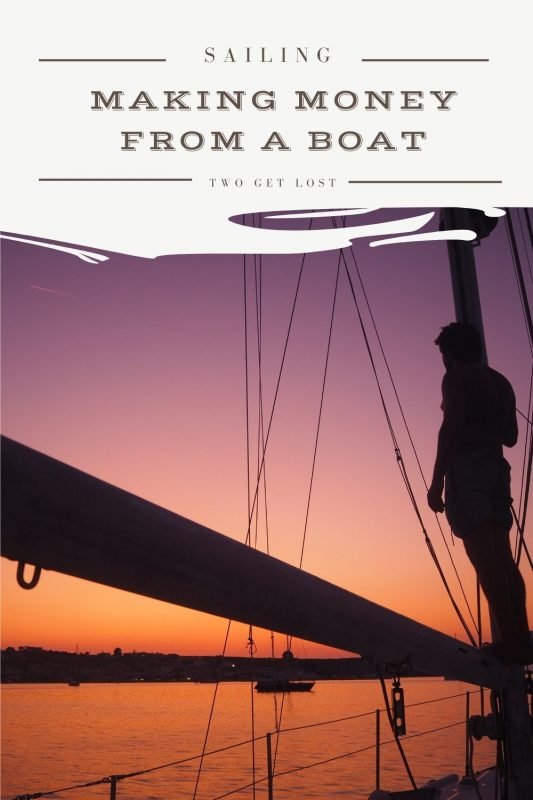
How to Make Money While Living on a Sailboat
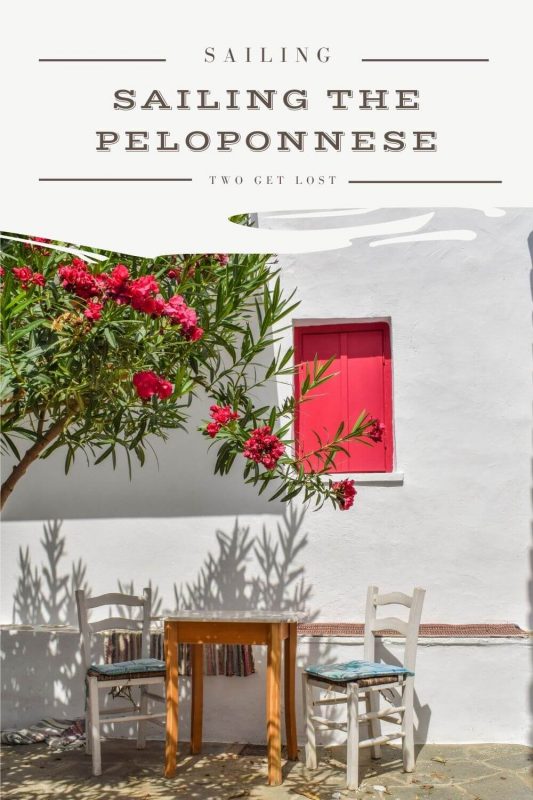
Sailing The Peloponnese In Greece
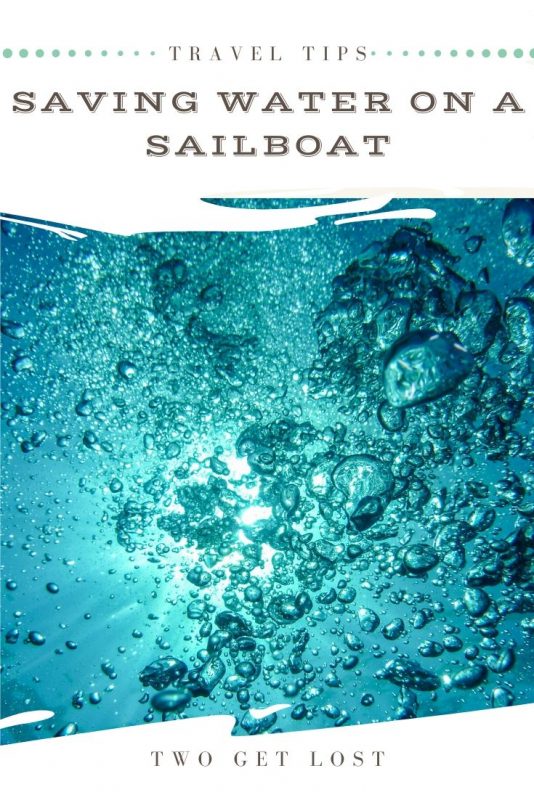
Saving Water On A Sailboat

Types of Sailboats by Type of Rig
16 December 2015
To have a better idea of which types of sailboats would best suit your needs, your Allied Yachting broker can advise you on the various options available on the market for new or second-hand vessels as well as new construction. In the meantime, here is a summarized guide to the different categories of sailing yachts by type of rig , whether they are monohull (single hull) or multihull , as they’re called in the Mediterranean.
Sailboats by rig type: hulls, masts

Single masted sailboat with monohull
The most common monohull modern sailing yacht is the sloop, which features one mast and two sails, thus sloops are single-masted sailboats. If they have just two sails — a foresail and a headsail — then they’re a Bermudan sloop, the purest type of sailboat. This simple configuration is very efficient for sailing into the wind.
Sailing sloops with moderate rigs are probably the most popular of all cruising sailboats. Just a single-masted sailboat with two sails (a foresail or headsail, and a mainsail) and the minimum of rigging and sail control lines they are relatively simple to operate and less expensive than rigs with multiple masts.
Sloops are adapted for cruising as well as racing, depending on the height and size of their rig.
The cutter sailing yacht is also a monohull similar to a sloop with a single mast and mainsail but generally carries the mast further aft to allow for a jib and staysail to be attached to the head stay and inner forestay, respectively. Once a common racing configuration, today it gives versatility to cruising boats, especially in allowing a small staysail to be flown from the inner stay in high winds.
Thus, a cutter-rig sailboat has an additional sail (the staysail) set on its own stay between the foresail and the headsail.
Cutters are mostly adapted for cruising, but capable of good performance while racing as well.
A ketch is a two-masted sailboat, the main-mast forward and a shorter mizzen mast aft.
But not all two-masted sailboats are ketches — they might be yawls.
A ketch may also carry a staysail, with or without a bowsprit, in which case it would be known as a cutter-rigged ketch.
Ketches are also monohulls, but there is a second shorter mast astern of the mainmast, but forward of the rudder post. The second sailboat mast is called the mizzen mast and its sail is called the mizzen sail.
Yawls have their origins as old-time sail fishing boats, where the small mizzen sail was trimmed to keep the vessel steady when hauling the nets.
Similar to a ketch, the difference being that the yawl has the mizzen mast positioned aft of the rudder post whereas the ketch has its mizzen mast ahead of the rudder post.
Thus, a yawl is also a monohull, similar to a ketch, with a shorter mizzen mast carried astern the rudderpost more for balancing the helm than propulsion.
Schooners are generally the largest monohull sailing yachts.
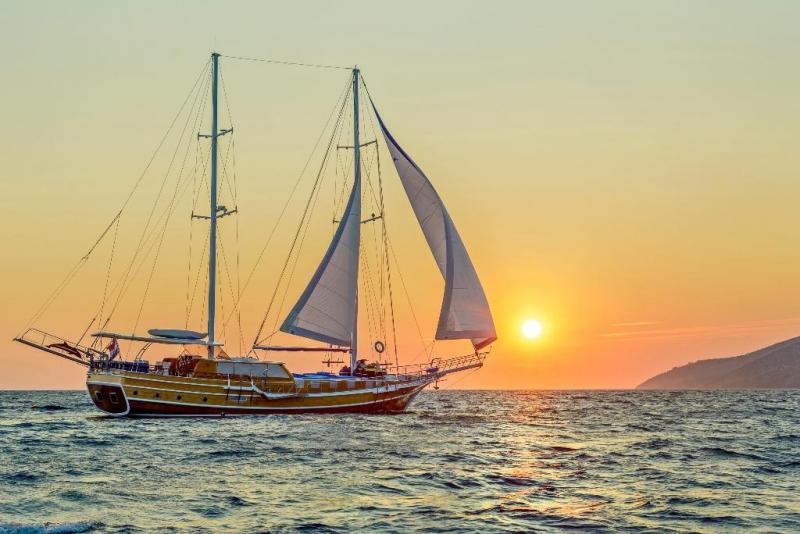
Monohull two masts sailing boat
A schooner has a mainmast taller than its foremast, distinguishing it from a ketch or a yawl. A schooner can have more than two masts, with the foremast always lower than the foremost main. Traditional topsail schooners have topmasts allowing triangular topsails sails to be flown above their gaff sails; many modern schooners are Bermuda rigged.
A schooner is a two-(or more) masted sailboat, in which the aft-most mast – the mainmast – is the same height or taller than the foremast. Many sailors agree that of all the different types of sailboats, a schooner under full sail is one of the most beautiful sights afloat.
Gaffed-rigged sailboats, or “gaffers”, have their mainsail supported by a spar – the “gaff” – which is hauled up the mast by a separate halyard. Often these types of sailboats are rigged with a topsail. The gaff rig is no longer seen on modern production yachts.
A catamaran (‘cat’ for short) is a multihull yacht consisting of two parallel hulls of equal size.
A catamaran is geometry-stabilized, that is, it derives its stability from its wide beam, rather than having a ballasted keel like a monohull. Being ballast-free and lighter than a monohull, a catamaran can have a very shallow draught. The two hulls will be much finer than a monohull’s, allowing reduced drag and faster speeds in some conditions, although the high wetted surface area is detrimental in lower wind speeds, but allows much more accommodations, living and entertaining space in stability and comfort.
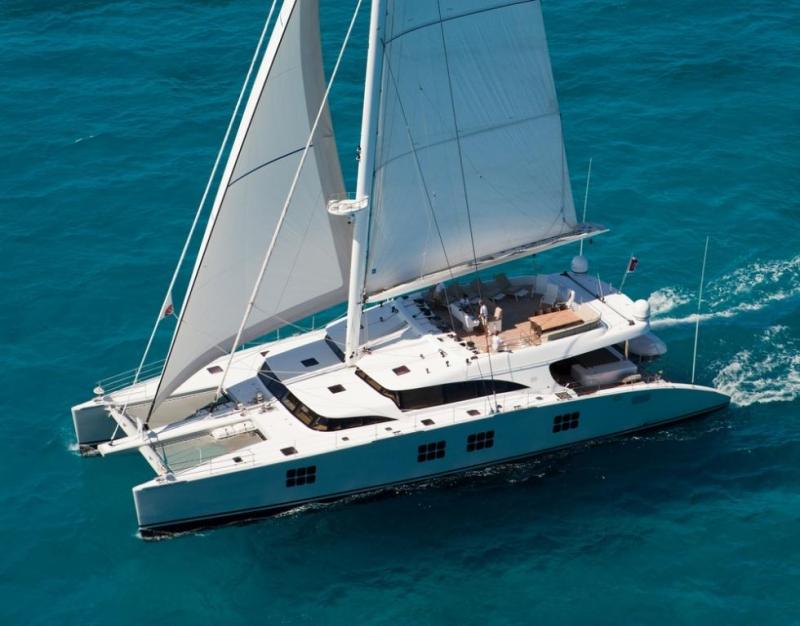
Two parallel hulls sailing catamaran
The speed and stability of these catamarans have made them a popular pleasure craft in Europe, most high-quality catamarans are built in France, but careful since their wide beams aren’t easy (or cheap) to berth in the French Riviera.
Racing catamarans technology has made them today’s leading racing sailboats of the world, like in the latest editions of America’s cup or other renowned transoceanic races.
Please surf through our website listings of sailing catamarans .
OTHER MULTIHULLS
Even harder to berth in the Mediterranean, and most commonly designed for around-the-globe racing rather than cruising, the trimarans have also been gaining some popularity in the western hemisphere, especially by naval designers with futuristic projects.
A trimaran is a multihull boat that comprises a main hull and two smaller outrigger hulls (or ‘floats’) which are attached to the main hull with lateral beams.
MOTORSAILER
A motorsailer or “motorsailor”, is a type of sailing vessel, typically a pleasure yacht, that derives propulsion from its sails and engine(s) in equal measure.
While the sailing yacht appeals primarily to the purist sailing enthusiast, the motorsailer is more suited for long-distance cruising, as a home for ‘live-aboard’ yachtsmen. The special features of the motorsailer (large engine, smaller sails, etc.) mean that, while it may not be the fastest boat under sail, the vessel is easily handled by a small crew. As such, it can be ideal for retired people who might not be entirely physically able to handle large sail areas. In heavy weather, the motorsailer’s large engine allows it to punch into a headwind when necessary to make landfall, without endless tacking to windward.
The Turkish word gulet is a loanword from the French goélette, meaning ‘schooner’.
A gulet is a traditional design of a two-masted (more common) or even three-masted wooden sailing vessel from the southwestern coast of Turkey, particularly built in the coastal towns of Bodrum and Marmaris; although similar vessels can be found all around the eastern Mediterranean. For considerations of crew economy, Diesel power is commonly used on these vessels, similar to a motorsailer. Today, this type of vessel, varying in size from 14 to 45 meters, is very popular and affordable for tourist charters in Turkey, the Aegean, Greece and up to Croatia in the Adriatic.
Please surf through our website listings of cruising sailing yachts by type of rig.
OUR YACHT LISTINGS:
- New Yachts for Sale
- Pre-owned Yachts for Sale
- Yachts for Charter
You might also like
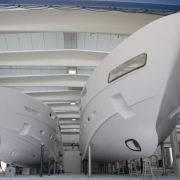
Yachting Consultants
Sale-Charter-Brokerage-Management
Headquarters:
34 Rue Caffarelli 06000 Nice, France
Front Office:
Boulevard de La Croisette – Port Canto 06400 Cannes, France
T.: +33 493 43 82 83 Email: [email protected] Website: www.alliedyachting.com

RetireFearless
What Is A Boat With 2 Masts Called?
We’re familiar with boats that have one mast. However, what about those with two? What is a boat with two masts called?

March 16, 2023
This article may contain affiliate links where we earn a commission from qualifying purchases.
Most sailors have a profound fascination for dual-mast boats. The great thing about such boats is that they offer a great level of balance. From an aesthetic viewpoint, boats with two masts appear beautiful and majestic. But what are they called?
The most common names for boats with two masts are Ketch, Yawl, Brig, and Schooner. The designs of these boats are variable, but the primary idea remains the same. An extra mast in the front is called the foremast, while an extra mast in the back is called a mizzenmast.
Usually, the aft-mast is shorter than the mainmast. The aft-mast, also known as the mizzenmast, stabilizes a sailboat while serving as a bow-thruster in some conditions. In windy conditions, the mainmast can be broken down while the mizzenmast remains intact, thus resulting in a comfortable and balanced sail.
As professional sailors, we take great pride in educating our readers about the different types of boats. Here are some of the most popular dual-mast boats.

Table of Contents
Yawls are the most common types of dual-mast boats out there. It has a mainmast and a mizzenmast. The mizzenmast is shorter than the mainmast. It is an oblique boat with the mainmast in the front, and the mizzenmast in the rear. The mizzenmast of the Yawl enhances the balance of the helm, and it is mostly located behind the rudder.
Another essential type of two-mast boat is the Ketch. This boat is often mistaken for a yawl. Therefore, it is better to understand the differences between the two. They both have the mainmast in the front, with the smaller mizzenmast in the rear end. The primary difference between these two is mast location.
In a yawl, the mizzenmast is situated behind the rudder, while in Ketches, the mizzenmast is located in front of the rudder post. In Ketches, the mizzenmast is just as big as the mainmast, and it carries a mainsail. The purpose of the mizzenmast is to keep the boat moving forward, especially when the conditions are aggressively windy.
On the flip side, the mizzenmast of a yawl can only enhance the helm balance. However, it cannot push the boat forward. Furthermore, the mizzenmast of the ketch is bigger than that of a yawl. It won’t be wrong to say that the mizzenmast of a Ketch is a driving sail, whereas that of a yawl is only a balancing sail.
If we compare a ketch to a sloop , the ketch enjoys a great advantage, especially when moving downward or against heavy winds. The reason behind its success is its versatile design, unlike a conventional sloop. The mizzenmast of a ketch depowers the wind in a number of different ways. It can also find the right amount of canvas for it to fly. It stabilizes the sailboat, provided it is placed in the right position.
Amongst other boats, a ketch offers a number of practical benefits, considering the different weather conditions a boat may face when on water. Apart from sailing smoothly on a beam-reach, ketches are easy to handle, which helps you learn faster if you are still a beginner.
Unlike a ketch, in a schooner , the foremast is smaller than a mizzenmast. Although you can't really spot the difference between the two masts, if you look closely, you will see the difference in their heights. The foremast will appear shorter than the mizzenmast. Unlike a schooner, a sloop has a single mast. However, the schooner is easier to sail, but it isn't as fast as a schooner. That being said, the schooner looks fabulous when under full sail.
The most common schooners out there are the ones with a square topsail. However, there are some shapes out there that run diagonally. On bigger sea routes, schooners with bigger sails aren't the most ideal boats. The reason is that a spirit rig cannot be lowered. If it is, it can become difficult to handle for some people. However, the spirit rig works perfectly in coastal conditions, provided the topsail is capable of catching a high breeze.
Just like the schooners and ketch, the Brigs also have two masts. However, the mainmast is squared, and in some cases, triangular. In some brig boats, the mainmast has a lateen mainsail. Initially, the brigs were used by pirates who pushed them forward using oars.
Therefore, the word brig has been derived from the Italian word brigantine, which means pirate. Before becoming sailboats, briggs were used by pirates in the Mediterranean back in the 16th century. Here are some kinds of brigs.
In a brigantine, the foremast is square in shape, while the mainmast is triangular.
Hermaphrodite Brig
This type of brig is also known as the half brig or the schooner brig. Both the masts on this boat are partially squared, but the primary mast is gaff-rigged. This design makes it the closest thing you can find to a schooner.
The great thing about brigs is that they are fast, maneuverable, and easy to handle. This is part of the reason why pirates used them in the 16th century. Pirates could easily hop in and leave without the fear of getting caught.
These were the most common boats with two masts. If you are a sailing enthusiast, you can opt for any one of them. However, there are a few factors you need to consider. The first two things to consider are your affordability and the reason for purchasing or renting a specific dual-mast boat.
You also need to consider your boating and sailing skills. If you lack experience and boating skills, it is in your best interest to opt for a ketch. Lastly, factor in the weather and the conditions you will be driving your boat in.
Recent Articles

What Size Sailboat Can One Person Handle?

How To Tie A Sailboat To A Mooring Ball Ring

What Is The Ideal Wind Speed When Sailing?

How To Use a Sailboat Winch

Things You Need To Liveaboard a Sailboat

Types of Sailboat Keels
I'm Michael Moris. I've been sailing my whole life, and it has taken me to places I never imagined. From the Caribbean to Europe, from New Zealand to South America - there's nowhere that hasn't felt like home when you're on a boat!

Trending Articles

How Far Is Havana From Miami By Boat?

Yachting Vs Sailing

Who Is Sailing Doodles?
Subscribe To Our Newsletter
Thank you! You're signed up for our free newsletter!
Oops! Something went wrong while submitting the form
About Our Team
We are a publishing team of licensed Nursing Home Administrators, Nurses, Assisted Living Directors, Health Professionals, Gardeners, and individuals with vast experience with senior living and activities.

©2024 Retire Fearless. All rights reserved.
We can be reached via email at [email protected]
Retirefearless.com is a participant in the Amazon Services LLC Associates Program, an affiliate advertising program designed to provide a means for sites to earn advertising fees by advertising and linking to Amazon. This site also participates in other affiliate programs such as CJ, ClickBank and more, and is compensated for referring traffic and business to these companies.
Facebook Pinterest

Two-Mast Sailboat Types
Numerous sailors have a soft spot for two-mast sailboats, and there really is something unique in two-mast sails, irrespective of whether you are a sailboat enthusiast or just an intrigued passerby.
The two masts are typically the first feature you observe on such a sailboat. The mainmast, or foremast will usually be larger than the rear mast, also known as the mizzenmast.
But aside from being elegant and impressive, a two-mast sailboat provides perfect balance, which can be best obtained by making adjustments to the masts in a variety of ways.
The mizzenmast acts as that shoulder you can rely on as it assists with the sailboat’s stability while it is moving, and it can also function as a propulsion system in certain situations.
So, let’s take a look below at various kinds of two-mast sailboats and their advantages!
What Do You Call A Sailboat With Two Masts?
Several sailboats have two masts (see also ‘ Sailboat Mast: Everything You Need To Know ‘), the four most popular of which we will explore in a bit. In these sailboats, the styles of their masts differ in most instances, but the basic concept stays the same.
All these sailboats come with an extra mast at the rear or the front of the foremast. If that supplemental mast is in front of the foremast, it is called a foremast; if it is behind it, it is called a mizzenmast.
Among the most popular two-mast sailing vessels is the yawl. It is equipped with a mizzenmast and a foremast. Typically, the mizzenmast will be relatively short, particularly when compared to the foremast.
This renders it an angled sailboat, seeing that the foremast is situated at the front of the boat and the mizzenmast is situated at the back. A yawl’s mizzenmast is situated toward the back of the boat steering mechanism and is primarily used to boost helm stability.
It’s very easy to mix up a yawl and a ketch, so it’s best to clear that up before proceeding. They both are two-mast sailboats, with the foremast at the front and the mizzenmast behind it.
The spot of the mast is what distinguishes a ketch from a yawl. The mizzenmast is placed behind the boat steering mechanism post in a yawl and in front of it in a ketch.
A ketch’s mizzenmast is approximately the same height as the foremast, and it is employed to hold the mainsail. Its primary purpose, though, is to propel the boat as well as sail it adequately, especially in stronger wind.
That very function contrasts with a yawl’s mizzenmast, which is only utilized to help with balancing the steering wheel and cannot propel the boat forward.
This indicates that a ketch’s mizzenmast is larger than a yawl’s mizzenmast. In summary, a ketch’s mizzenmast is a moving sail, whereas a yawl’s mizzenmast serves as a balancing one.
In downwind or wind gusts, a ketch is at a favorable position when compared to a sloop. This is due to the fact that it has more setup options than a standard sloop.
The rear mast allows the sailor to adjust in strong winds and choose the most appropriate percentage of canvas to move with.
Provided that the mizzenmast is typically in an ideal position, it may also aid in the stabilization of the sailboat under force.
Essentially, a ketch comes with numerous practical advantages that make it ideal for most scenarios on the water.
A ketch, other than cruising serenely on a beam reach, is completely controllable and can provide a wide range of possibilities in a variety of weather circumstances and situations.
A schooner can even have three masts, but the one with two typically has a fairly small mainmast and a bigger mizzenmast, which in essence becomes the mainmast.
As a result, the main feature of a schooner is that its masts are both tall and with little to no difference, with the rear mast, in some cases, being a bit taller.
A schooner is slower than a sloop, despite being simpler to navigate. That is why so many seafarers choose to sail with a sloop than with a schooner, although it’s still an impressive sight, and even more so when fully sailing.
Even though schooners with square-shaped sail is what most people often get, several other schooners available are equipped with diagonal sprit rigs.
Schooners that have spritsails are unsuitable for large sea routes as, when the sprit rig gets lowered, it becomes impossible to manage. The sprit rig, on the contrary, is perfect in coastal areas because the topsail can hold a high gust of wind.
The brig, same as all the previously mentioned sailing ships, is a two-mast sailboat, with the foremast being of a square shape.
The foremast may come in the shape of a square, part square, or triangle in design. The foremast of certain brigs has a lateen mainsail (see also ‘ The Definition And History Of The Lateen (Triangular) Sail ‘).
These sailboats have been heretofore employed by pirates and launched by oars. Its name originates from the Italian term “brigantine,” which roughly translates to “pirate.” Before becoming sailboats, such kinds of sailboats were employed by pirates in the 1500s.
The two most prevalent brig varieties are:
- Brigantine – The main mast is triangular, while the front mast is partly squared.
- Hermaphrodite brig – This brig is equipped with two slightly squared masts, with the mainmast being gaff-rigged and topsail, something that makes it a half schooner. That is why it is also referred to as the schooner brig or the half brig.
Brigs are simple to operate and navigate in terms of speed and drivability, which may be why pirates favored them, and they are usually bigger than the rest of the two-mast or single-mast sailboats.
The Benefits Of A Two-Masted Sailboat
But why might someone prefer a two-masted sailboat more than a single-masted one?
At first glance, perhaps it will look like a one-masted sloop is easier to control. However, having more masts and a wider range of sails to pick from has its benefits.

A Two-Masted Sailboat Has Greater Sail Area Division
When a sail area is split over a larger number of sails, the area for every sail becomes smaller and easier to navigate.
This is especially useful when moving with fewer passengers on board and in strong weather conditions.
A Two-Masted Sailboat Provides More Rough Weather Choices
If a cruiser encounters higher-than-expected winds, having more sails, and thus more alternatives, can be extremely beneficial.
Most ketch-rigged boats, for instance, can rest nicely in rising winds and waves with only the mizzen being used to hold the boat’s bow facing up into the wind, a practice called “heaving to.”
This tends to mean that the staff does not have to be on deck and can remain safely hidden below since the sail works on its own.
A Two-Masted Sailboat Provides More Sail Balance
Seafarers must be knowledgeable of sail balance if they want to maneuver a boat proficiently.
This entails ensuring that the sails are drawn in such a way that the sailboat can float in a horizontal line without having to utilize the rudder excessively in order to right the route.
A Two-Masted Sailboat Allows For Engine-Free Sailing
If you want the enjoyment of cruising without relying on an engine, or if your engine won’t work, knowing that you have a mizzen sail could be extremely advantageous.
The mizzen can be employed to float smoothly and in perfect control when trying to catch or deciding to leave a mooring ball.
The same is true for anchoring while sailing. This is definitely not an uncommon case scenario; we have all had to do something similar at least once in our lives.
A Two-Masted Sailboat Provides An Anchor Riding Sail
Even as you are sailing across the globe, you will inevitably come across an anchorage that is just not perfectly easy and serene.
The smallest wave that can create some kind of shuddering can make people onboard feel nervous and become dissatisfied with their sailing experience.
A two-mast sailboat will be in an advantageous position in this situation as the mizzen can be lifted and fastened in firmly to counteract the boat’s side-to-side moving.
It may also be counterbalanced by attempting to make use of the wind to direct the boat’s bow into the waves, resulting in a way steadier sailboat and a satisfied crew.
A Two-Masted Sailboat Is Nearly Impossible To Be Completely Dismasted
A two-masted sailboat has an extra benefit: the mizzen, while too small to push the sailboat at high speeds, can most likely get you back safe in case the mainmast breaks or is torn apart in extreme situations.
The Bottom Line
There are dozens of reasons why seafarers chant paeans to these sailboats. Even in windy conditions, you can break down the mainmast and employ the mizzen mast to provide a more aligned and pleasant voyage.
There are different kinds of two-mast sailboats, thus there is no single term that can fit them all.
The only thing that can group them is their two-mast feature, so if you decide to sail in one of them, it is up to your preference to choose which one will take you on your next adventure!
Related Posts:
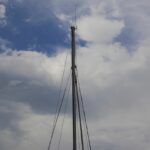
What's a Sailboat With Two Hulls Called? (3 Examples)
A sailboat with two hulls offers several advantages over traditional monohull sailboats, including greater stability, speed, and space. If you want to learn more about the types and key features of two-hulled sailboats, we'll give you three distinct examples and help you decide which one fits your needs.
A sailboat with two parallel hulls is known as a catamaran. The hulls are connected by a deck, which provides a wide and stable platform, allowing them to sail faster and more efficiently than monohulls. Some of the most common catamaran types include cruising catamarans, racing catamarans, and power catamarans.
Aside from a catamaran, there are other types of two-hulled sailboats, such as the proa and the Polynesian double canoe. Let's see how they differ from a catamaran and what their use or purpose is.
- Catamarans are proven safer than traditional sailboats with a single hull, and they are less likely to tip over.
- Catamarans typically have two sails, one on each mast, which are larger and more efficient than those found on traditional sailboats.
- Catamarans have a shallower draft which allows them to access shallow anchorages and navigate in areas where traditional sailboats cannot.
- Power catamarans provide the stability and space of a catamaran with the speed and convenience of a motorboat.
- The proa is a two-hulled sailboat with asymmetric hulls that only sails in one direction and has a minimalist design.
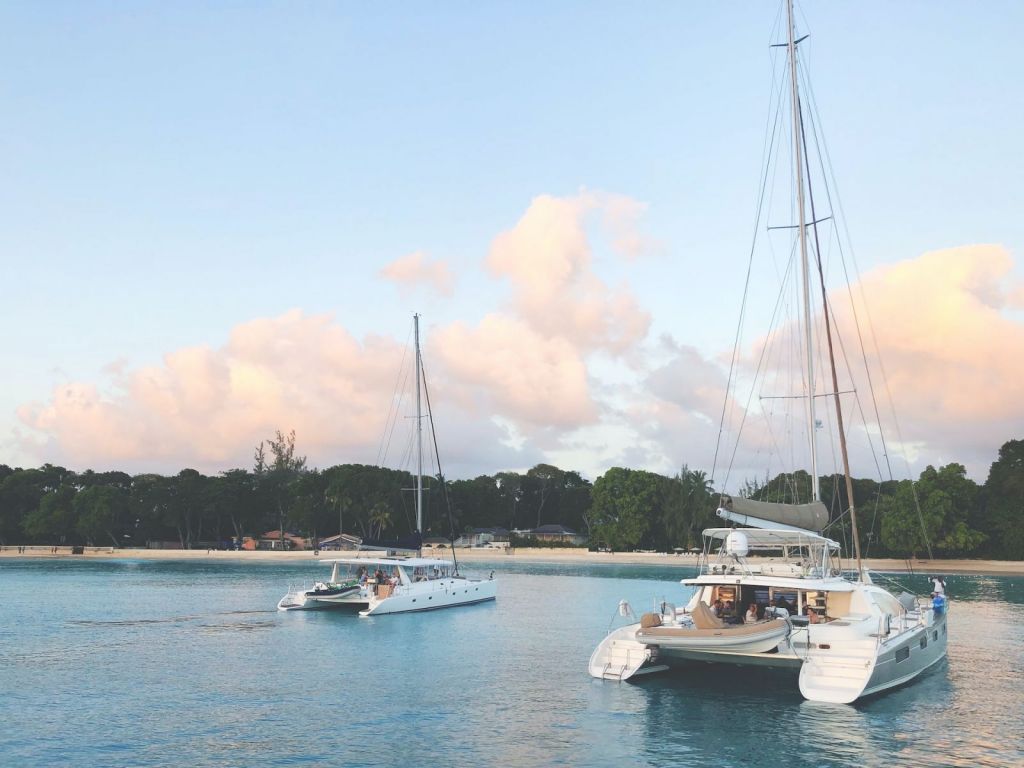
On this page:
The two-hulled sailboat: catamaran, 3 common types of catamarans, other types of two-hulled sailboats.
A sailboat with two hulls is popularly known as a catamaran . Catamarans are a popular choice for sailing enthusiasts due to their stability, speed, and comfort compared to monohulls , especially in rough seas.
The table below summarizes how you can identify a catamaran based on the presence and number of each part:
They have two hulls
Unlike traditional sailboats that have a single hull, a multihulled boat such as a catamaran is considered to have one of the most stable hull designs . This allows them to sail faster and more efficiently than traditional sailboats. They are also less likely to tip over, making them a safer option for inexperienced sailors.
The two hulls also provide a wider base which reduces the rolling motion that can cause seasickness. Additionally, they allow for more living space on the boat, making them suitable for long-term cruising and living aboard.
If you're curious if a catamaran can still capsize despite having two hulls, here's an article to answer your question.
The hulls can be made of various materials, including fiberglass, aluminum, and wood. Fiberglass is a popular option due to its durability, strength, and ease of maintenance.
Meanwhile, the aluminum's strength and resistance to corrosion can make it ideal for sailing in saltwater environments. Wood is a traditional material used for boat building and can provide a classic look to a catamaran, but it requires more maintenance than other materials and can be more susceptible to rot and damage.
Other materials that can be used for catamaran hulls include carbon fiber, Kevlar, and composites. These materials are lightweight and strong, so they are ideal for racing catamarans that require speed and agility.
They have two sails
Catamarans typically have two sails, one on each mast. The sails can be adjusted to catch the wind and propel the boat forward. They can sail faster than traditional sailboats due to their lightweight design and ability to catch more wind.
The sails are typically larger and more efficient than those found on traditional sailboats. This is because catamarans have a wider beam, which allows for a greater sail area without compromising stability.
The two sails on a catamaran are usually a mainsail and a jib. The mainsail is attached to the mast on the back of the boat, while the jib is attached to the mast on the front of the boat.
If you want to be familiar with the different types of sail , here's a full guide with illustrations.
The mainsail is the larger of the two sails and is responsible for most of the boat's propulsion. The jib is smaller and is used to help steer the boat and balance the sail plan.
Catamarans also have the ability to use a spinnaker sail. This is a large, lightweight sail that is flown from a pole at the front of the boat. The spinnaker is used when sailing downwind and can significantly increase the boat's speed.
Most catamarans have two masts
Most catamarans have two masts, one on each hull. The masts are typically placed near the center of each hull, which helps to distribute the weight of the sails evenly across the boat.
Some catamarans have tall, slender masts that are designed for speed and efficiency, while others have shorter, sturdier masts that are better suited for heavy winds and rough seas.
Aluminum is a common choice for catamaran masts because it is lightweight, strong, and relatively inexpensive. Carbon fiber, on the other hand, is a more expensive option that offers superior strength and stiffness, making it ideal for high-performance racing catamarans.
They have two rudders and two daggerboards
Catamarans typically have two rudders, one on each hull, that are used to steer the boat. These rudders are located at the stern of each hull and are controlled by a steering system that allows the helmsman to turn the boat left or right.
Some catamarans also have daggerboards, which are retractable keels that help the boat sail upwind. They are used to provide lateral resistance to the boat and prevent it from sliding sideways.
Read this article to find out the pros and cons of a daggerboard keel type .
They usually have two daggerboards, one in each hull, that can be raised or lowered as needed. A catamaran's daggerboard is usually made of a lightweight, high-strength material like carbon fiber.
Some catamarans use a combination of keels and daggerboards, with one or more fixed keels and one or more retractable daggerboards. This allows the boat to have the stability and resistance to leeway provided by the fixed keels, while also having the maneuverability and adjustability of the daggerboards.
Catamarans have a shallow draft
In general, catamarans have a shallower draft than monohull sailboats, which allows them to access shallow anchorages and navigate in areas where traditional sailboats cannot.
The draft of a catamaran with a daggerboard keel can vary depending on the position of the daggerboard. When the daggerboard is fully extended, it can increase the draft of the boat, while when it is fully retracted, it can reduce the draft. This allows sailors to adjust the draft of the boat depending on the conditions and the depth of the water.
Smaller catamarans designed for day sailing or coastal cruising may have a draft of only a few inches, while larger catamarans designed for ocean crossings may have a draft of several feet.
Read this article to find out the advantages and disadvantages of sailing a catamaran if you're planning to sail one.
Below is a table showing the different types of catamaran and their use and key features:
Cruising catamarans offer ultimate comfort for sailors
Cruising catamarans are designed for long-distance voyages and are popular among live-aboard sailors. These catamarans typically have spacious interiors with multiple cabins, a galley, and plenty of storage space. They also have a shallow draft, which allows them to navigate in shallow waters and anchor closer to shore.
If you're looking for the best liveaboard catamarans , here are a few top picks.
In addition to their spacious interiors and shallow draft, cruising catamarans also offer a stable and comfortable ride. The two hulls of the catamaran provide a wide beam, which makes them less likely to tip over and more resistant to waves and choppy waters. This stability also makes them a great option for families with children or for those who are prone to seasickness.
Cruising catamarans are also known for their speed and efficiency. The twin hulls reduce drag and allow for faster sailing speeds, while the large sail area provides plenty of power. This makes them ideal for long-distance voyages where speed and efficiency are important.
Racing catamarans are designed for speed and agility
Racing catamarans are specifically designed for speed and agility on the water. They are typically smaller and lighter than cruising catamarans, which makes them more maneuverable and faster in the water.
The hull shape of racing catamarans is also more streamlined, which reduces drag and allows them to cut through the water with less resistance. They also have a larger sail area which allows them to catch more wind and generate more power, which translates into greater speed on the water.
Racing catamarans are also typically equipped with high-performance sails, which are designed to be more responsive and efficient than those found on cruising catamarans. While they are best suited for open water and moderate to high winds, they may not be as stable in rough or choppy water conditions.
Power catamarans are designed for speed and efficiency
Power catamarans are designed for those who want the stability and space of a catamaran but prefer the speed and convenience of a motorboat.
Power catamarans are equipped with engines that provide propulsion, rather than relying on the wind to move them through the water. Their powerful engines can reach speeds of up to 30 knots.
Because they have two hulls, power catamarans are more stable in the water than traditional monohull powerboats. They also have a wider beam, which provides more space and stability on board.
The dual hull design reduces drag and allows them to move through the water more efficiently than monohull powerboats. This means that they can reach higher speeds with less fuel consumption, which makes them a popular choice for long-distance cruising or offshore fishing.
In terms of size, power catamarans can range from small, trailerable models to larger, luxury yachts. They are often equipped with modern amenities, such as air conditioning, generators, and entertainment systems, which make them comfortable for extended periods of time on the water.
The table below shows the two other types of two-hulled sailboats aside from catamarans:
Proa is a two-hulled sailboat
Proa sailboats, also known as outrigger canoes, are a type of boat that originated in the Pacific Islands. They have two hulls, with the main hull being longer and narrower than the smaller outrigger hull.
The proa sailboat has several distinctive characteristics that set it apart from a catamaran:
They have asymmetric hulls : The proa has two hulls of different sizes, with the main hull being longer and narrower than the outrigger hull. This asymmetry allows for efficient sailing in both directions.
They can only do unidirectional sailing : The proa is designed to sail in one direction only, with the outrigger hull always leading. This is in contrast to catamarans, which can sail in either direction.
They are mounted on an angled mast : The sail on a proa is mounted on an angled mast, which allows for efficient sailing in a wide range of wind conditions.
They have a simple design : Minimalist design: Proas are often designed with a minimalist approach, using simple materials and construction techniques to create a lightweight and efficient boat.
In contrast, catamarans have two hulls of equal size and are designed to sail in either direction. They typically have more complex rigging and sail arrangements and are often larger and more spacious than proas.
In some Pacific Island cultures, proa sailboats were used for fishing and transportation, while in others they were used for racing and sport. Today, proa sailboats are still used for a variety of purposes, including recreation, racing, and exploration.
In terms of structure and design, proa sailboats are typically made from wood or other natural materials and are often decorated with intricate carvings and designs. They can range in size from small, single-person boats to larger vessels capable of carrying multiple passengers and cargo.
The Polynesian double canoe is another twin-hulled sailboat
The Polynesian double canoe is another type of boat that originated in the Pacific Islands and is still used today. It is a large canoe that consists of two hulls connected by a platform or deck. The two hulls are typically of equal size, and the deck is usually made of wood or other natural materials.
The Polynesian double canoe was traditionally used for long-distance ocean voyages and was an important means of transportation and exploration for the Polynesian people. The design of the canoe allowed it to be easily maneuvered through the water, and it was able to handle a variety of wind and sea conditions.
One of the unique features of the Polynesian double canoe is the use of a crab claw sail, which is a triangular sail that is mounted at an angle to the mast. This type of sail is highly efficient and allows the canoe to sail close to the wind, making it well-suited for long-distance ocean voyages.
In addition to transportation and exploration, these canoes have also been used for fishing, trading, and warfare. Today, the Polynesian double canoe is still used in some Pacific Island cultures for traditional ceremonies and celebrations, as well as for recreation and sport.
Leave a comment
You may also like, are catamarans safer than monohulls - not always.
While many people believe that catamarans are inherently safer due to their stability and buoyancy, others believe that monohulls offer better handling in rough …
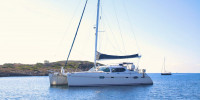
Can a Catamaran Capsize? The Surprising Answer
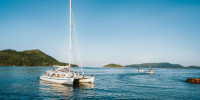
The Perfect Size Catamaran to Sail Around the World
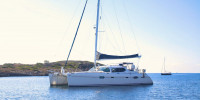
13 Best Liveaboard Catamarans (For All Budgets)
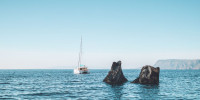
Average Cost of Buying & Owning a Catamaran (With 4 Examples)
Own your first boat within a year on any budget.
A sailboat doesn't have to be expensive if you know what you're doing. If you want to learn how to make your sailing dream reality within a year, leave your email and I'll send you free updates . I don't like spam - I will only send helpful content.
Ready to Own Your First Boat?
Just tell us the best email address to send your tips to:
Aft : The rear of a boat, close to the stern Backstay : A mast support that runs from the top of the mast to the stern of the boat. It may be adjustable in order to bend the mast backward or to increase tension on the forestay tool Ballast : Weight in the keel of a boat that adds stability Beam : A boat's greatest width Beating : Sailing (or pointing) at an angle into the wind or upwind. Since sailboats cannot sail directly into the wind, "beating" is the closest course to the wind they can sail. Bilge : The lowest part of a boat's hull
Blanketing : A tactical maneuver in which one boat slows a competitor by positioning itself to obstruct the competitor's wind Block : An assemblage of one or more sheaves (pulleys) housed in a plastic or metal case that changes the direction of travel of a line (rope) and may be attached to a boat's deck, spar or other stationary object Boom : Spar to which a sail's lower edge or foot is attached. The boom is attached to the mast at the gooseneck. Boom vang : Lines that control the boom. These lines run from the boom to the base of the mast and are used when reaching and running. Bow : The front of the boat Broach : When in a downwind situation, the boat turns uncontrollably and is pushed by the wind onto its side, lying with the mast parallel to the water. As a rule, the boat will right itself. Buoy : A floating marker Cam cleat : A mechanical cleat used to hold a line automatically. It uses two spring-loaded cams that come together to clamp their teeth on the line, which is placed between them. Also known as jam cleat . Centerboard : Like a keel, it is a weighted appendage projecting below the boat that keeps it from capsizing and also supplies the hydrodynamic lateral force that enables the boat to sail upwind. Unlike a keel, it is retractable. Cleat : A fitting, typically with projecting ends, that holds a line against the tension from the sails, rigging or mooring Clew : The lower corner of a mainsail or jib and either lower corner of a spinnaker Coming about : Turning the boat so the bow crosses through the eye of the wind, thereby changing the side of the yacht on which the sails are carried. Also known as tacking. Covering : A tactical maneuver in which a boat stays between a competitor and the wind or the next mark Daggerboard : An adjustable fin primarily used to stop the boat moving sideways through the water. Also known as centerboard. Dinghy : The Laser, Laser Radial, 470, and Finn are all dinghies that have been used in Olympic sailing - they all have one hull and a centreboard or daggerboard Downwind : The point of sail when the wind blows from aft of the boat's beam Drag : The negative or retarding force acting on a body, such as a boat moving through a fluid parallel and opposite to the direction of motion Fall off : A maneuver in which a boat turns away from the wind Fleet racing: Competition format were entries race against each other around a course Foot : The bottom edge of a sail Genoa/Headsail/Jib : The smaller sail set in front of the mast Gooseneck : A fitting that attaches the boom to the mast Gybe : Turning the boat so the stern crosses through the eye of the wind, (thereby changing the side of the boat on which the sails are carried (opposite of tacking). Also spelled jibe. Halyard : A line used to hoist and hold up a sail Header : Wind shift that causes the boat to head away from the mark Helmsman : The crew member who steers the boat; also the skipper, or the "driver" Hiking out : Leaning out of the craft in order to change the center of gravity in the boat and go faster Hiking straps : Straps attached to the feet that help a sailor hike out more, minimizing the chance of falling out of the boat Hull: The main body or shell of a ship or other vessel, including the bottom, sides, and deck ISAF : International Sailing Federation, the world governing body of sailboat racing Jam cleat : A device used to grip a line (rope). It has two rows of V-shaped molded teeth that grip the line when it is jammed in the groove. Also known as cam cleat. Jib : A foresail that overlaps the shroud base and is used for sailing upwind Jibe : Same as the gybe -- turning the boat so the stern crosses through the eye of the wind, thereby changing the side of the yacht on which the sails are carried (opposite of tacking) Kee l: A weighted, non-moveable appendage projecting below the boat that keeps it from capsizing and also supplies the hydrodynamic lateral force that enables the boat to sail upwind Kite : Large, light ballooning sails that are only attached to the mast at the corners. They are used when sailing downwind. Also known as spinnaker . Knot : One nautical mile per hour Lay : To sail a course that clears an object or racecourse marker buoy such as the windward and leeward marks. When a boat is doing so, it is said to be "laying the mark." Layline : An imaginary line projecting at an angle and corresponding to the wind direction from either side of a racecourse marker buoy that defines the optimum sailing angle for a boat to fetch the mark or the finish line. When a boat reaches this point, it is said to be "on the layline." Going beyond the layline means the boat is sailing a greater distance to reach the mark or finish line. Leech : The trailing edge of a sail or the curve of a sail Leeward : The side furthest away from the wind Lines : A nautical term for ropes Luff, to : Bubbling or flapping of a sail when it is not trimmed enough or is being back winded by another sailor when the course sailed is too close to the wind Mainsail : The sail behind the mast Mark : A buoy used in a racecourse Mast : The vertical spar that holds up the sails Match racing : A racing format in which only two boats compete at a time, as opposed to fleet racing, wherein three or more boats sail at once Medal race : The final race in the series. Only the top-10 boats after the opening series compete and scores are doubled. Multihull : Nacra 17 (boat used in its inaugural event at the 2016 Rio Olympic Games) - A boat with more than one hull. A boat with two hulls is also known as a catamaran and a boat with three hulls is knows as a trimaran. Nautical mile : The unit of geographical distance used on saltwater charts; one nautical mile equals 6,076 feet or 1.15 statute miles. Therefore, one statute mile equals 0.87 of a nautical mile. Off the wind : Sailing away from the wind; also downwind, reaching or running Plane : A boat planes when it sails over her own bow wave so only a small section of the hull is in the water. This allows the boat to go faster than the theoretical maximum hull speed. Pointing : Sailing at an angle into the wind or upwind. Depending on a boat's design, some will "point higher" or sail more directly into the wind and thus sail a shorter course to a given mark on the racecourse. Port : Nautical term for the left side of a boat when facing forward Port tack : Sailing with the wind blowing onto the port side and the mainsail on the starboard side Race officials : The officials responsible for running the race and enforcing the rules. This group includes the measurers who ensure that each sailor's equipment is equal and within the rules, the race officers who run the races and the judges and umpires who are rules experts and make decisions about whether rules have been broken. Reef : To decrease a sail's size Rigging : The wires, lines, halyards and other items used to attach the sails and the spars to the boat. The lines that do not have to be adjusted often are known as standing rigging. The lines that are adjusted to raise, lower and trim the sails are known as running rigging. Rudder : A moveable fin located underneath the back of the boat that steers the craft Running rigging : All moving rods and lines that support and control the mast and sails Shackle : A metal connector that attaches to other fittings with the use of a pin that is inserted through the arms of a U Sheet : A line that controls sails Skiff : 49er - A light open dinghy with a self-draining hull Slalom finish : A technical section of the windsurfing (RS:X) course involving multiple changes of direction in quick succession Spar : A basic term for a mast, boom or yard Spinnaker : Large, light ballooning sails that are only attached to the spars at the corners. They are used when running or reaching, sailing downwind. Starboard : Nautical term for the right half of the boat when facing forward Starboard tack : Sailing with the wind blowing onto the starboard side and the mainsail on the port side Stern : The rear of the boat Tacking : Turning the boat so the bow crosses through the eye of the wind, thereby changing the side of the boat on which the sails are carried (opposite of gybing) Tiller : A lever used to turn the rudder of a boat from side to side Trapeze : To stand on the side of the boat to maximize the effect of the body weight Trim : To adjust the sail to the right shape and angle to the wind. The process of "hiking out," or changing the center of gravity of the boat in order to go faster. Upwind : Toward the direction from which the wind blows; windward. Way : Forward motion of a boat. A term typically used in the context of saying that a boat is making way, is underway, or has way on. Windward : The side closest to the wind
Note: Some components of NBCOlympics.com may not be optimized for users browsing with Internet Explorer 11, 10 or older browsers or systems.
Advertisement
The Dali was just starting a 27-day voyage.
The ship had spent two days in Baltimore’s port before setting off.
- Share full article

By Claire Moses and Jenny Gross
- Published March 26, 2024 Updated March 27, 2024
The Dali was less than 30 minutes into its planned 27-day journey when the ship ran into the Francis Scott Key Bridge on Tuesday.
The ship, which was sailing under the Singaporean flag, was on its way to Sri Lanka and was supposed to arrive there on April 22, according to VesselFinder, a ship tracking website.
The Dali, which is nearly 1,000 feet long, left the Baltimore port around 1 a.m. Eastern on Tuesday. The ship had two pilots onboard, according to a statement by its owners, Grace Ocean Investment. There were 22 crew members on board, the Maritime & Port Authority of Singapore said in a statement. There were no reports of any injuries, Grace Ocean said.
Before heading off on its voyage, the Dali had returned to the United States from Panama on March 19, harboring in New York. It then arrived on Saturday in Baltimore, where it spent two days in the port.
Maersk, the shipping giant, said in a statement on Tuesday that it had chartered the vessel, which was carrying Maersk cargo. No Maersk crew and personnel were onboard, the statement said, adding that the company was monitoring the investigations being carried out by the authorities and by Synergy Group, the company that was operating the vessel.
“We are horrified by what has happened in Baltimore, and our thoughts are with all of those affected,” the Maersk statement said.
The Dali was built in 2015 by the South Korea-based Hyundai Heavy Industries. The following year, the ship was involved in a minor incident when it hit a stone wall at the port of Antwerp . The Dali sustained damage at the time, but no one was injured.
Claire Moses is a reporter for the Express desk in London. More about Claire Moses
Jenny Gross is a reporter for The Times in London covering breaking news and other topics. More about Jenny Gross

IMAGES
VIDEO
COMMENTS
1. 1976 Westerly Center Cockpit Ketch. This 1976 Westerly Center Cockpit Ketch is a small 36-foot long sailboat with two masts. This is a solidly built cruising vessel that features a center cockpit ketch layout. This boat has a small 38 horsepower engine perfectly fit to navigate its smaller size.
Five Ocean-Going Sailboats With Two Masts. Some of the most reputable boat builders in the world favor ketch and yawl rigs. Some popular sailboats with two masts used nowadays include the Nicholson 38, the Bayfield 40, the Amel Super Maramu, the Hinckley Bermuda 40, and the Bowman 46. Let's look at each model.
The Hinckley Bermuda 40 is a classic sailboat that has been around since the 1960s. This boat is known for its beautiful lines, excellent handling, and comfortable interior. The Bermuda 40 is a yawl-rigged sailboat, which means it has two masts, a mainmast, and a smaller mast called a mizzenmast.
Ketch is a type of sailboat that features two masts and two sails, commonly used as a racing and cruising boat. The mainmast of this two-masted sailboat is typically taller than the mizzen mast (aft-mast). Its name derives from catch. Taller masts allow you to use larger sails, so ketch boats are able to achieve better speeds than similar boats ...
Yawl. A yawl is one of the most common types of two-mast sailboats. It has two masts: a mizzenmast and the mainmast. The mizzenmast is usually much shorter than the mainmast. This makes it an oblique type of a sailboat in the sense that the mainmast is located in the front of the boat while the mizzenmast is located in the rear past or the boat.
A catamaran is a type of cruising and racing multihull sailboat with two hulls. The hulls are always the same size. Most catamarans have a standard Bermuda rig. The catamaran refers to the hull, so it can have any number of masts, sails, sail types and rig type. How to recognize a catamaran: any boat with two hulls is called a catamaran
Boats with two masts that have a mizzenmast are most likely a yawl or ketch. The two-masted rigs are: Lugger - two masts (mizzen), with lugsail (a cross between gaff rig and lateen rig) on both masts; Yawl - two masts (mizzen), fore-and-aft rigged on both masts. Main mast is much taller than mizzen. Mizzen without a mainsail.
Let's look at what a ship with two masts might be called and the difference between each type: ketch, yawl, schooner, brig and brigantine. We'll also dive into some benefits of two masted sailboats. ... A ketch is a two-masted sailboat. The rear mast, called the mizzen mast, is shorter than the forward main mast. The mizzen mast is mounted ...
Some multi-hull sailboats have side-by-side masts, but these are the exception. Catamaran Sailboats. The second most common sailboat configuration is the catamaran. A catamaran is a multihull sailboat that has two symmetrical hulls placed side-by-side and connected with a deck.
Schooner. A schooner is another boat with 2 masts, but can also have more. Like the brig and brigantine, a two-masted schooner has a foremast and an aft mast, the latter essentially being the mainmast. The main characteristic of the schooner is the masts are almost the same size, with the foremost mast sometimes being slightly shorter.
A cutter is a sailboat with two masts, which can be either a sloop or a ketch. The mainmast is taller than the shorter mizzen mast, and they are both located forward of the rudderpost. Cutters are among the most common types of sailboats. The design helps balance out heavy winds in all directions with its two sails and symmetrical rig (mainsail ...
Learn about the pros and cons of a sailboat with two masts in this detailed post. Conclusion on Small Bluewater Sailboats. As you can see, there are a lot of budget boats out there for sailing around the world. There's been a comeback in the market for these bluewater boats as more young people get into cruising.
Mast configurations and sail combinations are another way of categorizing sailboats. These are just a few of the most common types. Sloop The most common type of sailboat is a sloop. A sloop has one mast and two sails, a mainsail and a headsail. Depending on the size and shape of the headsail, it may be called a jib, genoa or spinnaker.
Ketch, yawl, or schooner — types of sailboats with two or more masts. Monohull — a boat with only one hull. Catamaran — a boat with two equal-sized hulls in the water that are connected together by a bridge deck. Trimaran — a boat with three hulls in the water, the center of which is much larger than the outer two.
What Are Boats With Two Sails Called? Boats with two sails are called cutters or sloops. Both have a mast with two sails, but a cutter has two foresails, while a sloop has a mainsail and a jib. Ketches are also sailboats but feature more than one mast with multiple smaller sails. There are a variety of sailboats out there.
A sailboat mast is a vertical, upright structure that supports the sails of a sailboat. It is a crucial component of the boat's rigging system and plays a key role in harnessing the power of the wind to propel the vessel. Typically located in the center of the boat, the mast extends upward from the deck or hull.
KETCH. A ketch is a two-masted sailboat, the main-mast forward and a shorter mizzen mast aft. But not all two-masted sailboats are ketches — they might be yawls. A ketch may also carry a staysail, with or without a bowsprit, in which case it would be known as a cutter-rigged ketch. Ketches are also monohulls, but there is a second shorter ...
Sailing Boats with 2 Masts. If the extra mast is in front of the main mast, it is called a foremast, but if the additional mast is behind the main mast, it is called a mizzen mast. Let's review these two-masted sailing boats, starting with the ketch: 1. Ketch.
The most common names for boats with two masts are Ketch, Yawl, Brig, and Schooner. The designs of these boats are variable, but the primary idea remains the same. An extra mast in the front is called the foremast, while an extra mast in the back is called a mizzenmast.
A two-mast sailboat will be in an advantageous position in this situation as the mizzen can be lifted and fastened in firmly to counteract the boat's side-to-side moving. It may also be counterbalanced by attempting to make use of the wind to direct the boat's bow into the waves, resulting in a way steadier sailboat and a satisfied crew.
A sailboat with two parallel hulls is known as a catamaran. The hulls are connected by a deck, which provides a wide and stable platform, allowing them to sail faster and more efficiently than monohulls. Some of the most common catamaran types include cruising catamarans, racing catamarans, and power catamarans.
The Crossword Solver found 30 answers to "Sailboat with two masts", 4 letters crossword clue. The Crossword Solver finds answers to classic crosswords and cryptic crossword puzzles. Enter the length or pattern for better results. Click the answer to find similar crossword clues . Enter a Crossword Clue. Sort by Length. # of Letters or Pattern.
Mast: The vertical spar that holds up the sails Match racing: A racing format in which only two boats compete at a time, as opposed to fleet racing, wherein three or more boats sail at once Medal race: The final race in the series. Only the top-10 boats after the opening series compete and scores are doubled.
The ship had two pilots onboard, according to a statement by its owners, Grace Ocean Investment. There were 22 crew members on board, the Maritime & Port Authority of Singapore said in a statement.